Pain Applications
The biopsychosocial model is a compelling approach to conceptualizing and treating chronic pain disorders. Practitioners who utilize this model understand the importance of the medical, psychological, and psychophysiological assessment of pain patients. Biofeedback is often efficacious and cost-effective in treating common pain disorders like low back pain and tension-type and migraine headache. Biofeedback training may allow clients to reduce medication consumption and emergency room visits. Medication-overuse headache (MOH) complicates migraine treatment.
Tension-type headaches are produced by an interaction of peripheral and central processes. Peripheral processes may be most important in episodic and central processes in chronic headaches. Trigeminal nerve involvement is found in chronic tension-type headache.
Vascular headaches may be triggered by a hypothesized hypothalamic headache generator. Classic migraines, which involve prodromal symptoms, are preceding by spreading cortical depression. Breakthrough headaches precede and are worsened by the dilation of cranial blood vessels. The trigeminal nerve is a final common path for headache pain. The mechanisms responsible for cluster and migraine headaches appear to differ.
The mechanism by which temperature biofeedback impacts migraine has been questioned, especially by research showing that the direction of temperature training does not affect treatment outcome.
Research in Raynaud's disease has yielded unexpected benefits for the field of biofeedback. We have learned that hand-warming and hand-cooling involve separate mechanisms and that temperature biofeedback may not reduce sympathetic activation. Raynaud's research has also supported the local fault model of Raynaud's disease and challenged the traditional model that effective treatment reduces sympathetic arousal.
Since the release of Evidence-Based Practice in Biofeedback and Neurofeedback (3rd ed.), there has been stronger evidence of biofeedback efficacy for low back pain, pediatric headache, and repetitive strain injury.
BCIA Blueprint Coverage
This unit addresses Chronic neuromuscular pain (IV-C), General treatment considerations (IV-D), Target muscles, typical electrode placements, and SEMG treatment protocols (IV-E), and Pathophysiology, biofeedback modalities, and treatment protocols for specific ANS biofeedback applications (V-D).

This unit covers Tension-Type Headache, Vascular Headache, Raynaud's Disease and Phenomenon, Low Back Pain, Myofascial Pain, Temporomandibular Disorders (TMD), Cervical Injury, Workplace Ergonomic Applications, and Complex Regional Pain Syndrome (CRPS).
Please click on the podcast icon below to hear a full-length lecture.

EVIDENCE-BASED PRACTICE (4TH ED.)
We have updated the efficacy ratings for clinical applications covered in AAPB's Evidence-Based Practice in Biofeedback and Neurofeedback (4th ed.).
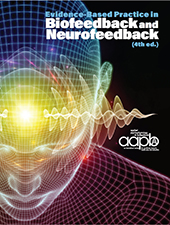
Tension-Type Headache
Tension-type headache (TTH) is characterized by a steady, nonthrobbing pain that may involve the frontotemporal vertex or occipito-cervical areas with a lateral or bilateral distribution. This headache has a duration of 30 minutes to 7 days.
Listen to a mini-lecture on Tension-Type Headache Overview © BioSource Software LLC. Graphic © sirtravelalot/Shutterstock.com.
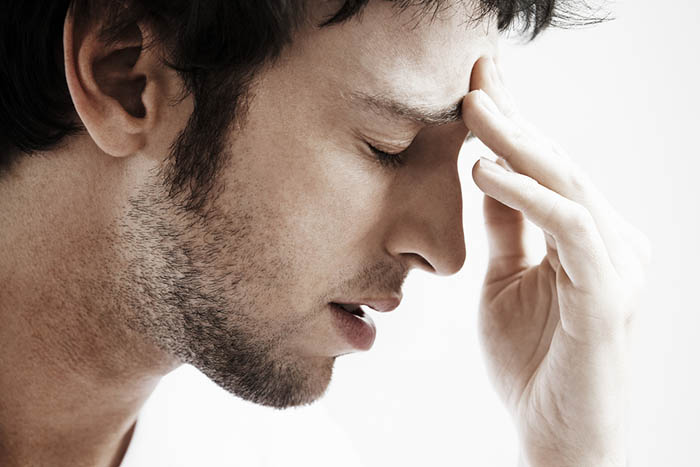
Demographics
TTH is the most common primary headache, and estimates of its lifetime prevalence range from 30-78%. TTH onset frequently occurs in the teenage years. There is a 3:2 female-to-male ratio (Blanda, 2015).
Graphic © Africa Studio/Shutterstock.com.
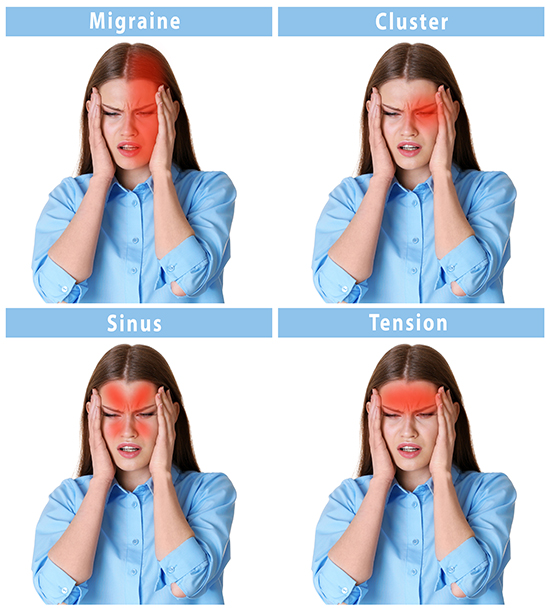
Tension-Type Headaches
TTH is divided into episodic and chronic headache. Episodic TTH is diagnosed when the patient has at least 10 previous headaches, fewer than 15 days per month, and no evidence of a secondary headache disorder.
Chronic TTH is diagnosed when there is an average headache frequency of more than 15 days per month for more than 6 months (Martin & Elkind, 2005).
Physiology of Tension-Type Headache
The consensus view is that tension-type headaches are produced by an interaction of peripheral and central processes (Ashina, Bendtsen, & Ashina, 2005; Chen, 2009). Central sensitization appears to play a crucial role, particularly in chronic TTH cases.This process involves increased excitability of the central nervous system, triggered by repetitive and sustained pericranial myofascial input. These changes may produce sympathetic nervous system activation that increases muscle contraction by shortening muscle spindles and constricting their blood supply (Ashina et al., 2002; Khazan, 2013). The sensitization occurs at both the spinal/trigeminal level and supraspinal level (e.g., periaqueductal grey, thalamus, somatosensory cortex, anterior cingulate cortex, and insula), potentially leading to impaired modulation of incoming stimuli in chronic TTH.
Peripheral mechanisms are thought to be more prominent in episodic TTH. These include myofascial pain and tenderness in pericranial muscles, as well as increased muscle hardness in pericranial areas. In chronic TTH, these muscular changes may become more permanent (Bhoi, Jha, & Chowdhury, 2021). However, it's important to note that the exact relationship between muscle tension and TTH remains controversial, as electromyogram (EMG) studies often fail to detect increased resting muscle tension in TTH patients (Millea & Brody, 2002).
Neurotransmitters such as nitric oxide (NO), calcitonin gene-related peptide (CGRP), substance P (SP), neuropeptide Y (NPY), and vasoactive intestinal polypeptide (VIP) are involved in pain processing and may contribute to the pathophysiology of chronic head pain, including TTH (Ashina, 2004).
Abnormalities in the metabolism of tyrosine and tryptophan, which are precursors to neurotransmitters, have been observed in chronic tension-type headache patients. Specifically, low plasma levels of tryptamine, a derivative of tryptophan, suggest insufficient serotoninergic control of the pain threshold, which may contribute to the chronicity of TTH (D'andrea et al., 2015).
While stress is a known contributor to TTH, the precise mechanisms by which it influences headache development are not fully understood. Stress may affect central pain processing, myofascial tenderness, and pain modulation and inhibition systems (Ashina, Bendtsen, & Ashina, 2005; Bhoi, Jha, & Chowdhury, 2021).
In conclusion, TTH is likely a multifactorial disorder involving both peripheral and central mechanisms. The relative importance of each factor may differ between episodic and chronic forms of the condition. Ongoing research continues to refine our understanding of TTH pathophysiology, which may lead to more targeted and effective treatments in the future.
While not linearly related to headache pain, almost two-thirds of these patients exhibit elevated SEMG activity in the cervical paraspinal, upper trapezius, frontalis, and temporalis muscles at baseline and during stressful tasks (Hatch et al., 1992).
These patients frequently show pericranial muscle tenderness and contraction, leading to central sensitization and chronic pain. The trapezius animation below is courtesy of Wikipedia.
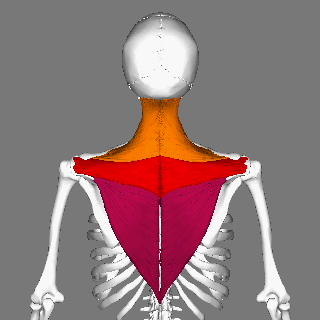
Forehead and Pericranial Muscle SEMG Assessment
Recent studies have shown that tension-type headache patients have higher SEMG levels than healthy controls. Researchers have monitored frontalis, occipitalis, temporalis, and trapezius muscles to study the role of muscle activity in tension-type headache.Listen to a mini-lecture on SEMG Findings for Tension-Type Headache © BioSource Software LLC. A frontalis or bifrontal placement is illustrated below.
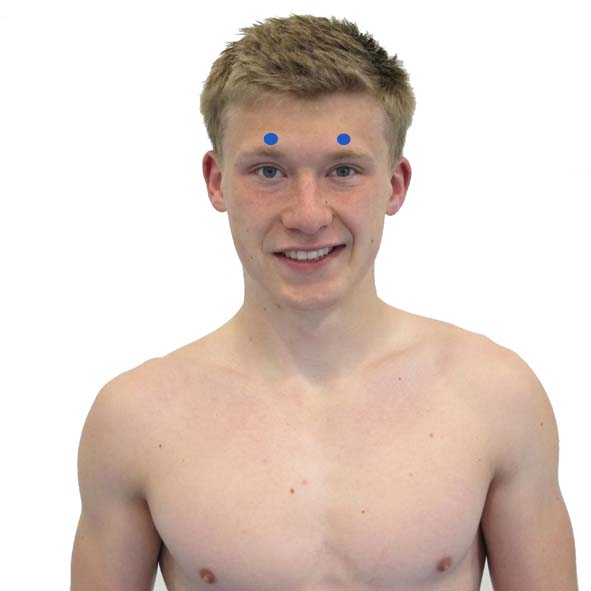
A cervical paraspinal placement is indicated below.
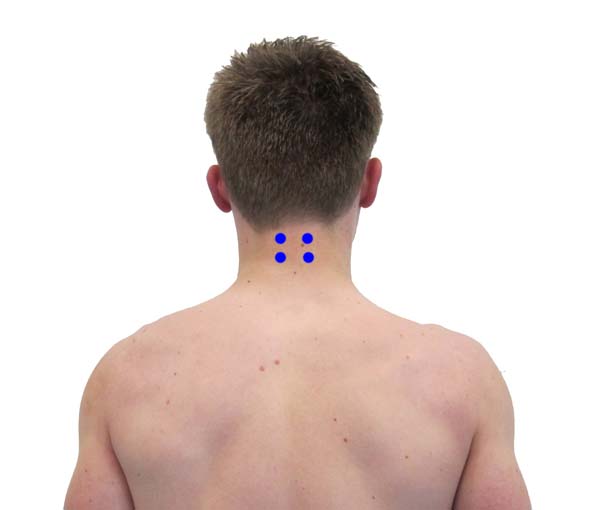
An FpN placement involves an active electrode over a frontalis muscle and another over a cervical paraspinal muscle on the same side below the hairline (Schwartz & Andrasik, 2003). A clinician could simultaneously monitor two FpN channels: left frontalis-left cervical paraspinal and right frontalis-right cervical paraspinal.


Hudzinski and Lawrence (1988) reported that both right- and left-sided FpN (frontalis and posterior neck) placements significantly discriminated between chronic tension-type headache patients when they had a headache and when they were headache-free.
Schoenen et al. (1991) reported higher left frontalis, temporalis, and trapezius muscles during reclining, standing, and math stressor conditions (62.5% of patients exceeded 2 standard deviations). Studies of tension-type headache patients have not consistently shown elevated SEMG activity during headache episodes, compared with when they are headache-free. One study found that frontal SEMG levels were significantly lower during a tension-type headache (Hatch et al., 1992).
The inconsistency among studies may be due to differences in recording sites, positions, tasks, and patient characteristics.
Biofeedback Treatment of Tension-Type Headache
The design of a treatment protocol should be based on the clinical outcome literature for the population you are treating (e.g., children, adults, elderly) and the findings of a psychophysiological profile that examines multiple response systems during resting, stress, and recovery conditions. Tailor treatment to your patient’s unique response stereotypy.Listen to a mini-lecture on Tension-Type Headache Treatment Components © BioSource Software LLC.
Several treatment components should be considered:
- frontal SEMG biofeedback
- masseter SEMG biofeedback
- temporalis SEMG biofeedback
- trapezius SEMG biofeedback
- temperature biofeedback
- relaxation training
- cognitive behavior therapy
Click on the Read More button to review complementary treatment components.

Complementary treatment components include:
- heat packs and diathermy
- ice packs
- massage
- prescription muscle relaxants like Zanaflex (Tizanidine)
- physical therapy exercises to increase range of motion
Pediatric Headache
Herman and Blanchard's (2002) review of studies involving biofeedback treatment of pediatric headache supported the efficacy of thermal biofeedback. A majority of studies found an average 50% reduction in headache symptoms.A meta-analysis by Trautmann, Lackschewitz, and Kroner-Herwig (2006) revealed that relaxation training produced greater symptom reduction than a wait-list control for pediatric migraine and tension-type headache patients.
A meta-analysis by Verhagen et al. (2005) found no evidence of biofeedback's effectiveness in treating pediatric headaches.
Clinical Efficacy
Based on at least two independent RCTs and several quasi-experimental studie, Ethan Benore (2023) rated biofeedback for pediatric headache as efficacious in Evidence-Based Practice in Biofeedback and Neurofeedback (4th ed.)ADULT HEADACHE
Blanchard (1992) summarized the findings of his headache studies since 1980:- good maintenance was shown in tension-type headache for biofeedback,
relaxation, and cognitive interventions
- long-term improvement was best for patients who practiced “some” or “as needed”
- limited contact (3 sessions) provided comparable headache relief to intensive contact (16 sessions)
- adding a brief cognitive stress management component to Progressive Relaxation training increased headache relief
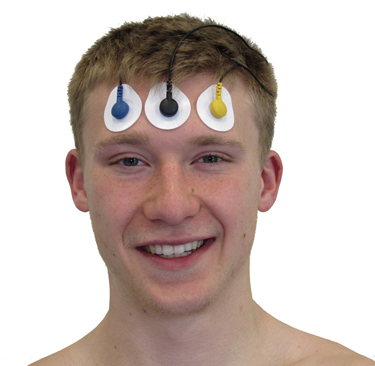
Down-training neck muscles may be necessary in treating tension-type and migraine headaches for two reasons. First, contraction of these muscles may help trigger a headache episode. Second, neck muscles often contract following a breakthrough headache to reduce head movement and the pain that it might cause. Graphic © Ohyperblaster/Shutterstock.com.
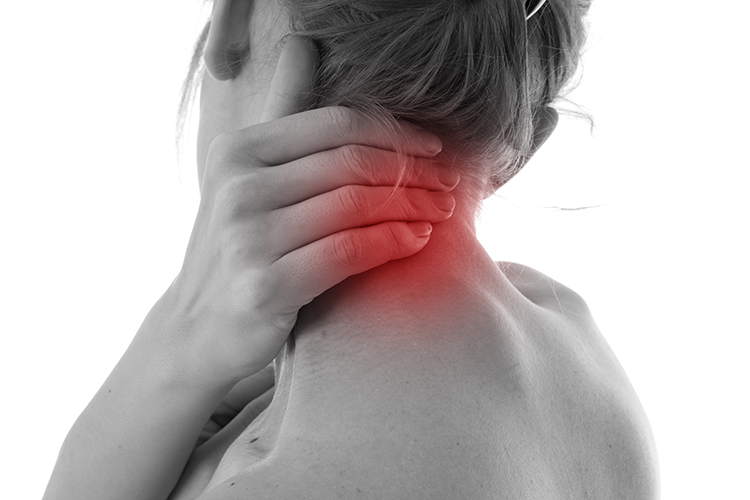
A combination of frontal and neck placements may provide clients with more information. Clinicians should be aware that neither the frontal or neck placements represent other muscle sites and that reductions at either of these sites may not generalize to other muscle groups.

Arena, Bruno, Hannah, and Meader (1995) compared forehead and trapezius SEMG biofeedback with a Progressive Muscle Relaxation control condition to treat tension headaches. Trapezius SEMG biofeedback produced the best clinical outcomes.
The National Institutes of Health Technology Assessment Panel (1996) concluded that SEMG biofeedback was superior to psychological placebo and comparable to relaxation therapies in treating tension headache.
The National Headache Foundation's Standards of Care for Headache Diagnosis and Treatment (1999) found that "biofeedback has been shown to be an excellent treatment in the long-term management of migraine and tension-type headache disorders" (p. 17).
A meta-analysis by McCrory et al. (1996) showed that SEMG biofeedback, relaxation therapy, and cognitive-behavioral therapy were moderately effective treatments for tension-type headache. A review of more than 100 studies by McGrady et al. (1999) found that biofeedback, relaxation training, and stress management training produced an average 50% reduction of headache pain.
Barton and Blanchard (2001) reported treatment failure with 10 of 12 patients (83%) suffering from moderate-to-high intensity chronic daily headaches who completed training. The treatment program consisted of 20 sessions, including progressive muscle relaxation, thermal biofeedback, and cognitive stress coping therapy. The authors warned that these patients are relatively refractory to self-regulatory training.
Moss, Andrasik, McGrady, Perry, and Baskin (2001) argued: "Biofeedback also has particular advantages over most medical treatments for headaches. Not only can it produce long-term remission of symptoms, but it does so without side effects. On the contrary, common side effects of medical treatments of headache include weight gain, sedation, and impaired concentration, and headache medications frequently lose their effectiveness over time. There is even preliminary evidence to suggest that successful treatment with biofeedback and relaxation can result in substantial cost savings."
Vasudeva, Claggett, Tietjen, and McGrady (2003) demonstrated that biofeedback-assisted relaxation produced more significant clinical improvement and cerebral blood flow measured by a transcranial Doppler procedure than self-directed relaxation.
Kaushik, Kaushik, Mahajan, and Rajesh (2005) reported that a combination of thermal and EMG biofeedback was comparable to propranolol for migraine and superior to propranolol during the first year after treatment.
Martin, Forsyth, and Reece (2007) randomly assigned patients to a combination of temporal pulse amplitude biofeedback, cognitive-behavioral therapy (CBT), or a wait-list. CBT resulted in a 68% reduction in headaches compared with 56% for the temporal pulse amplitude biofeedback and 20% for the wait-list.
Nestoriuc, Martin, Rief, and Andrasik (2008) reported a sizeable average effect size (69% success rate) for EMG biofeedback compared to 31% improvement in untreated control groups in their meta-analysis. Although their subjects had reported an average of over 14 years of headache, treatment only required an average of 11 sessions. Patients maintained treatment effects for an average follow-up period of 14 months.
Antidepressants
Several studies have shown that tension-type headache patients with elevations on measures of depression, like the Beck depression inventory and MMPI scale 2 (depression), respond more poorly to biofeedback and relaxation training (Jacob et al., 1983; Blanchard et al., 1985; Neff et al., 1985).Antidepressants have proven valuable in treating chronic tension-type headaches. Fluoxetine (Prozac) reduced headache activity in a double-blind placebo-controlled trial conducted by Saper et al. (1994). Amitriptyline (Elavil) was more effective for prophylactic treatment than citalopram (Celexa) and placebo in a double-blind study (Bendtsen et al., 1996).
Clinical Efficacy
Brown and Steffen (2016) rated SEMG biofeedback for adult headache as level 4 - efficacious in Evidence-Based Practice in Biofeedback and Neurofeedback (3rd ed.).Vascular Headache

Migraine Classification
A migraine with aura (classic migraine) features a prodrome or neurological symptoms that precede a breakthrough headache, hours to days before headache onset. Migraine with aura accounts for up to 31% of all migraine patients (Launer et al., 1999). The headache is preceded (10-20 minutes) by painless neurological symptoms that are mainly visual (scintillating scotomata and visual field defects) and last from 20-60 minutes. Headache onset may occur at any time and lasts 4-72 hours (Martin & Elkind, 2005).Listen to a mini-lecture on Migraine Diagnostic Criteria © BioSource Software LLC.
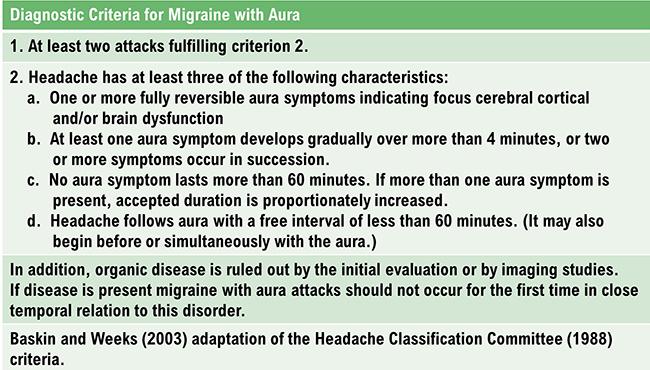
About 64% of all migraine patients experience migraine without aura, which is also called common migraine (Launer et al., 1999; Elkind, 2005).
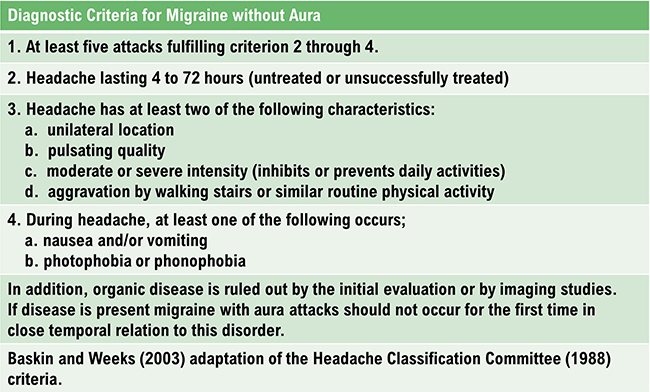
Complicated Migraines
Click on the Read More button to review complicated migraines.
Migraine equivalents are prodromes without headaches.
Migrainous infarction (complicated migraine) involves less than 1-2% of migraineurs. It includes hemiplegic, ophthalmoplegic, and basilar migraine. Complicated migraine is a vascular headache with neurologic symptoms that often follow a definite sequence. In severe cases, permanent neurologic deficits may follow the attack (Diamond & Dalessio, 1986).
Ophthalmoplegic migraine involves non-pulsating, moderate pain (often with vomiting), and paralysis of one or more extraocular muscles that move the eyes. This disrupts the coordination of eye movement and results in double vision. Following the headache, these symptoms may persist from 45 minutes to 2 months (Cruciger & Mazow, 1978).
Basilar artery migraine has prodromal symptoms that last from 2-45 minutes. Symptoms include total blindness, altered consciousness, and vertigo, and ataxia (involving the brainstem). Patients experience severe pulsating occipital headache with vomiting that persists for hours or until sleep. This headache is often observed in adolescent girls.
Baskin (2014) observed that a migraine patient's brain is more vulnerable to psychiatric disorders. They are 5.8 times more likely to develop depression. Depression complicates treatment because depressed migraine patients are 3 times less likely to adhere to treatment and show a reduced response to both medication and behavioral interventions. Anxiety generally precedes the onset of episodic migraine and may complicate migraine treatment more than depression. Episodic migraine can transform into a chronic headache with sleep disorder and anxiety.
Overuse of rescue medication can result in medication-overuse headache (MOH). Withdrawal from caffeine and immediate relief medication can produce more severe headaches. Analgesics hamper headache treatment. Chronic daily headache (CDH) is 19.4 times more likely when patients overuse medication.
Demographics
More than 30 million Americans report at least one migraine headache each year. Migraine affects 18% of women and 6% of men. One in six women experiences migraines (Chawla, 2014).Cluster Headache
Cluster headache (CH) episodes start abruptly without prodromes, 2 to 3 hours after falling asleep. They feature intense, throbbing, unilateral pain involving the eye, temple, neck, and face for 15 to 90 minutes. A typical pattern is one headache every 24 hours for 6-12 weeks followed by a 12 months of remission (Diamond & Dalessio, 1986; Martin & Elkind, 2005).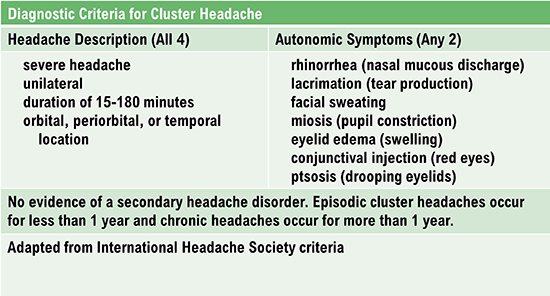
Listen to a mini-lecture on Cluster Headache Overview © BioSource Software LLC.
Demographics
The prevalence of CH in the United States is uncertain with a rate that is 2-9% of migraines. The male-to-female ratio is about 2:1, compared to a 6:1 ratio reported in the 1960s. Women are more likely to experience cluster headache onset earlier than men and a second increase in frequency after age 50 (Blanda, 2015).Hypothalamic Headache Generator
Emerging evidence implicates the hypothalamus as a central generator in primary headache disorders, notably migraines and cluster headaches. Functional neuroimaging studies have consistently demonstrated activation of the hypothalamus during headache episodes, suggesting its pivotal role in both the initiation and modulation of these conditions (Burstein et al., 2019; Schulte & May, 2016). Hypothalamus graphic © Alila Medical Media/Shutterstock.com.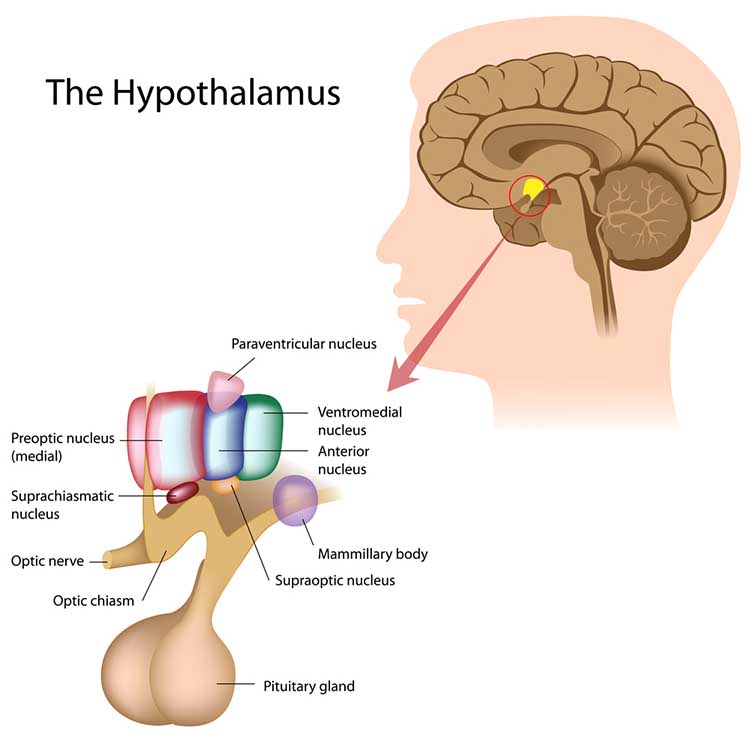
In migraines, the hypothalamus is believed to contribute to the prodromal phase, characterized by symptoms such as altered mood, fatigue, and food cravings. These premonitory symptoms, occurring hours to days before the headache onset, are thought to result from hypothalamic dysfunction affecting homeostatic processes (Giffin et al., 2003). The subsequent activation of the trigeminovascular system leads to the headache phase, with the hypothalamus modulating pain sensitivity and autonomic responses (Schulte & May, 2016).
Cluster headaches exhibit a striking circadian rhythmicity, with attacks often occurring at the same time each day. This pattern points to the involvement of the hypothalamic suprachiasmatic nucleus, the body's primary circadian pacemaker. Positron emission tomography scans have revealed activation of the posterior hypothalamus during cluster headache attacks, further supporting its role in their pathogenesis (May et al., 1998).
The hypothetical mechanism underlying hypothalamic involvement in primary headaches involves its regulatory influence over autonomic and endocrine functions. Dysregulation within the hypothalamus may lead to abnormal activation of the trigeminovascular system, resulting in the release of vasoactive neuropeptides and subsequent neurogenic inflammation. This cascade culminates in the sensitization of central pain pathways and the manifestation of headache symptoms (Burstein et al., 2019).
In summary, the hypothalamus plays a critical role in the pathophysiology of primary headaches, acting as a generator that influences the onset and characteristics of migraine and cluster headache attacks. Ongoing research into hypothalamic function and its interactions with pain pathways holds promise for developing targeted therapies for these debilitating conditions.
Key Differences Between Migraine and Cluster Headache Pathomechanics
The key differences in the pathomechanics of migraine and cluster headache are significant and multifaceted. One of the most striking distinctions is the periodicity of attacks. Cluster headaches exhibit a unique circadian and circannual rhythm, often occurring at the same time each day or during specific seasons, which is not typically observed in migraines. This pattern suggests a stronger involvement of the hypothalamus in cluster headaches.Autonomic symptoms also differentiate these conditions. While both may present with some autonomic features, they are far more prominent and consistent in cluster headaches, manifesting as ipsilateral conjunctival injection, lacrimation, nasal congestion, or ptosis. In contrast, migraine-associated autonomic symptoms tend to be less severe and more variable.
The quality of pain differs markedly between the two. Migraine pain is characteristically throbbing or pulsating, often described as a deep ache that worsens with physical activity. Cluster headache pain, on the other hand, is typically non-throbbing, extremely severe, and often described as burning, piercing, or stabbing.
Duration is another key differentiator. Migraine attacks are generally longer-lasting, typically persisting for 4 to 72 hours if untreated. Cluster headache attacks, while intensely painful, are usually shorter, lasting between 15 minutes to 3 hours.
Finally, the behavioral response to attacks varies significantly. During a migraine, sufferers typically seek a quiet, dark environment and prefer to lie still. In stark contrast, individuals experiencing a cluster headache often become restless and agitated, frequently pacing or rocking back and forth in an attempt to alleviate the pain.
These distinct clinical features reflect the underlying differences in the pathomechanisms of migraine and cluster headache, highlighting the involvement of different neural pathways and brain regions in their respective pathogeneses.
Physiology of a Vascular Headache
The trigeminal nerve shown in yellow may be activated in all primary headaches--cluster, migraine, and tension-type. A neurovascular theory of migraine based on imaging studies has replaced the poorly supported vascular theory of the 1940s that proposed that migraines are due to blood vessel dilation.Listen to a mini-lecture on the Neurovascular Theory of Headache © BioSource Software LLC.
Graphic © S K Chavan/Shutterstock.com.
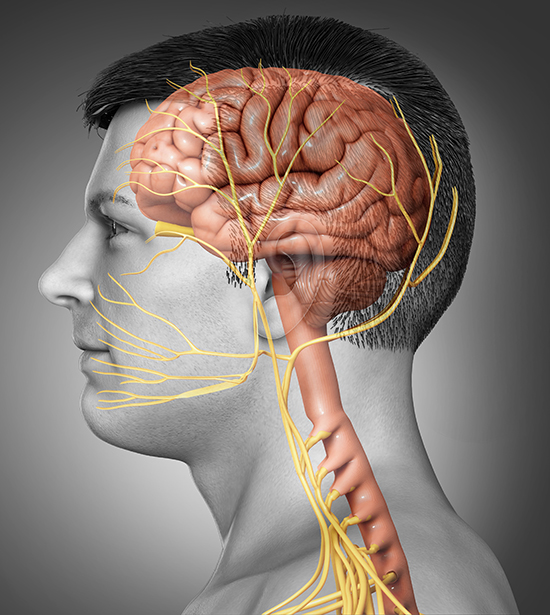
The neurovascular theory hypothesizes that migraine sufferers are vulnerable to cortical hyperexcitability, especially in the occipital cortex. A wave of cortical spreading depression (CSD) originates in the occipital lobe at the back of the head and moves toward the frontal lobe.
Listen to a mini-lecture on the Physiology of Migraine Pain © BioSource Software LLC. Graphic © S K Chavan/Shutterstock.com.

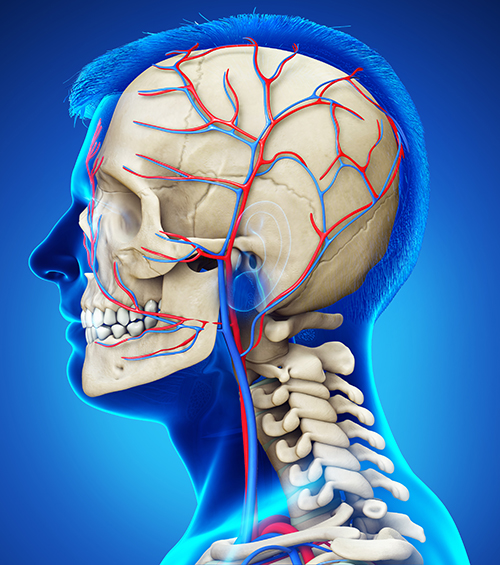
CSD produces hyperexcitability in these cortical neurons that is followed by inhibition. CSD activates the trigeminal nerve, triggering a breakthrough headache (Breedlove & Watson, 2013; Khazan, 2013).
The trigeminal nerve receives sensory information about the region from the jaw to the scalp and controls eight muscles. These muscles include the masseter, temporalis, lateral and medial pterygoids, tensor veli palatini, mylohyoid, digastric (anterior), and tensor tympani.
Compared to occasional tension-type headache patients, migraine patients may be hypersensitive to headache triggers and have an abnormally low threshold for activating the trigeminal nerve. Repeated migraine episodes may reduce migraineurs' ability to block pain. Graphic © Sebastian Kaulitzki/Shutterstock.com.
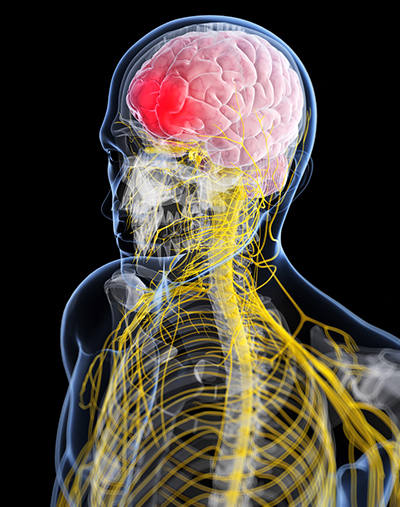
Diverse internal triggers (hormonal fluctuations, stress, and sleep deprivation) and external triggers (allergens, diet, and weather changes) increase the firing of neurons in the brainstem, hypothalamus, and cortex, which send signals to the migraine generator that produce nausea and vomiting. Baskin (2014) observed that a drop in estrogen levels was the most common migraine trigger.
A hypothesized migraine generator in the dorsal raphe nucleus of the upper brainstem activates the trigeminal nerve, whose extensive branches cover the brain "like a helmet" and initiate the migraine. Check out the Association of Migraine Disorders' YouTube video Migraine Pathophysiology.
Trigeminal nerve endings in the brain's dura mater release proteins that dilate blood vessels and increase the nerves' sensitivity. Thus, blood vessel swelling is the effect, instead of the cause, of a migraine headache. Graphic below © 2006 by Zygote Media Group, Inc.

Caption: This image illustrates the lateral view of the male head and neck, with arterial blood supply to the brain in relation and vertebral column represented. The following arteries are represented: arteria carotis interna, arteria carotis communis, arteria vertebralis, arteria cerebri media, arteria cerebri anterior, arteria basilaris, and arteria cerebri posterior.
Siniatchkin and colleagues (2000) reported that young migraine patients without aura showed larger slow cortical potential (SCP) amplitudes and less ability to reduce cortical negativity than healthy controls. SCP biofeedback training reduced cortical excitability and headache symptoms.
Kropp, Siniatchkin, and Gerber (2002) found that SCP amplitude and the delay of habituation were greatest in the few days before the next migraine attack. They concluded that these findings support the model that migraine results from "cortical hypersensitivity, hyperactivity, and a lack of habituation" (p. 203).
Lang and colleagues (2004) used magnetoencephalography to identify a population of hyperexcitable primary somatosensory cortical neurons that may play a role in migraine. They found that neuron hyperexcitability in the interictal state (between headache episodes) is correlated with migraine frequency. They proposed that it underlies the brain's vulnerability to migraine episodes.
Imaging studies have shown that migraine pain is not primarily due to vasodilation. Increased blood flow occurs hours after an aura has ended and a breakthrough headache has started. Cutrer (1999) demonstrated that the auras that precede classic migraines are due to cortical spreading depression instead of vasoconstriction.
Throbbing headache pain is produced by the dilation of blood vessels in the dura mater of the brain, which contains sensory neurons. Activation of these nerve fibers releases neuropeptides like calcitonin gene-related peptide (CGRP) and substance P. These peptides stimulate pain receptors and increase blood vessel dilation (Mathew & Buchholz, 2002). Pain signals travel to the trigeminal nucleus caudalis in the brainstem and the thalamus and cortex in the forebrain for processing (Baskin & Weeks, 2003).
These neuropeptides may further irritate trigeminal pain sensors to lower the pain threshold and prolong a migraine for up to 72 hours (Cutrer, 1999). Successive migraine episodes may impair the periaqueductal gray matter's ability to suppress pain due to increased iron deposition in this region (Welch, 2002).
Several researchers have reported elevated pericranial muscle contraction in migraine (Bakal & Kaganov, 1977; Gannon et al., 1987; Lichstein et al., 1991).
Migraine and Stroke
Etminan's (2004) meta-analysis of 14 studies revealed that male and female migraine patients, with and without aura, had twice the risk of stroke compared with those without migraine. A more controversial finding was that female migraine patients who also used birth control pills had about eight times the stroke risk compared with women without migraines not using this medication. Migraine, birth control pills, and smoking may additively increase stroke risk by promoting clot formation.Diet
Medina and Diamond (1978) reported that diet plays a relatively minor role in migraine pain for most patients. Khazan (2014) observed that specific foods trigger roughly 5% of migraines. For this small segment of migraine patients, the systematic elimination of alcohol, chocolate, aged cheeses, processed meats, MSG, nitrates, and nitrites may help to identify their unique triggers. Unstable blood sugar levels due to prolonged gaps between meals or poor nutrition are a more common migraine trigger than specific foods.Designing Biofeedback Protocols
Treatment protocol design should follow medical assessment and be based on the clinical outcome literature for the population you are treating (e.g., children, adults, elderly) and the findings of a psychophysiological profile that examines multiple response systems during resting, stress, and recovery conditions. Tailor treatment to your client’s unique response stereotypy.Listen to a mini-lecture on Migraine Treatments © BioSource Software LLC. Graphic © Derya Draws/Shutterstock.com.

A broad spectrum of treatment components should be considered based on the migraine:
- frontal SEMG biofeedback
- trapezius SEMG biofeedback
- temperature biofeedback
- blood volume pulse biofeedback
- passive infrared hemoencephalography
- slow cortical potential (SCP) neurofeedback
- qEEG neurofeedback
- cognitive behavior therapy
- relaxation training (e.g., autogenic training)
Biofeedback Studies
Click on the Read More button to review biofeedback and neurofeedback studies that treated vascular headaches.
Diamond et al. (1979) reported that 75% of 556 migraine patients treated with biofeedback and relaxation training experienced pain reduction. Pain reductions were relatively permanent in 37% of these patients.
Diamond and Montrose (1984) reported that 51% of 693 migraine patients treated with biofeedback and relaxation training experienced excellent or moderate improvement.
Sargent, Solbach, Coyne, Spohn, and Segerson (1986) found that 136 patients who received thermal biofeedback with autogenic training, autogenic training, or frontal SEMG biofeedback experienced greater reductions in headache activity than the no-contact control group. The three treatment groups did not differ in their reduction of headache activity.
There is little demonstrated efficacy of biofeedback and relaxation for cluster headache. Blanchard, Andrasik, Jurish, and Teders (1982) found modest improvement in 2 of 11 (19%) patients at 22- to 30-month follow-up.
Blanchard (1992) concluded that the efficacy of behavioral treatments for cluster headaches has not been demonstrated.
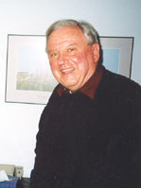
Blanchard et al. (1985) reported that relaxation alone resulted in improvement in 23.8% of vascular headache patients and 41% of tension headache patients. Relaxation with temperature biofeedback resulted in improvement in 52% of combined tension headache and vascular headache patients and 52% of vascular headache patients. The strongest treatment outcome predictors were patient age, trait anxiety, and MMPI scales 1 (Hyponchondriasis) and 3 (Hysteria). Symptom reduction was maintained for 1 year following treatment.
Blanchard et al. (1990) reported in a study of 148 patients with migraine or combined headache that the effectiveness of thermal biofeedback with relaxation was not increased by adding cognitive therapy. The two biofeedback conditions were not superior to the pseudomedication placebo condition.
Blanchard and Diamond (1996) cautioned that there has never been a demonstration of the superiority of temperature biofeedback or temperature biofeedback combined with relaxation to a credible placebo. Blanchard (1992) concluded in his summary of his headache research since 1980 that both hand-warming and hand-cooling provided comparable headache relief.
Blanchard and colleagues (1997) randomly assigned 70 patients with chronic vascular headache to one of four treatments that consisted of 12 treatment sessions, scheduled twice a week:
- TBF for hand-warming
- TBF biofeedback for hand-cooling
- TBF biofeedback to stabilize hand temperature
- biofeedback to suppress alpha
Holroyd and Penzien's (1990) meta-analytic review revealed that both propranolol and relaxation/ biofeedback reduced migraine headache activity by an average of 43% based on daily recordings and 63% based on other outcome measures (physician/therapist ratings). They also reported that propranolol and relaxation/ biofeedback did not differ in effectiveness.
Cott et al. (1992) compared eight weeks of autogenic training alone, autogenic training combined with SEMG (frontalis) biofeedback, and autogenic training combined with temperature biofeedback over a 12-month follow-up period. Autogenic training combined with SEMG biofeedback produced superior headache activity reduction than autogenic training alone or autogenic training combined with temperature biofeedback.
McGrady, Wauquier, McNeil, and Gerard (1994) reported that biofeedback-assisted relaxation produced greater improvement in transcranial Doppler measurements of cerebral blood flow than self-guided relaxation.
An Agency for Health Care Policy and Research meta-analysis concluded that temperature biofeedback, relaxation, and cognitive-behavioral interventions were moderately effective for treating migraine compared to a wait-list control (Goslin et al., 1999).
Silberstein's (2000) review of migraine treatment for the American Academy of Neurology-U.S. Consortium recommended SEMG and temperature biofeedback as effective treatments when delivered in the context of relaxation training.
Siniatchkin and colleagues (2000) studied the efficacy of SCP neurofeedback in treating 10 children with migraines without aura. The neurofeedback group was compared with 10 healthy children and 10 children with migraines placed on a waiting list. Following 10 training sessions, the children who received SCP training increased their regulation of cortical negativity during transfer trials (where no feedback was provided), reduced cortical excitability, and reported fewer days with migraine and improvement in other headache symptoms. The authors speculated that SCP training might have helped these patients by normalizing their regulation of cortical excitability.
Nestoriuc and Martin (2007) reported that blood volume pulse biofeedback was superior to EMG or temperature biofeedback and that a medium effect size was maintained at 17-months follow-up.
Nestoriuc, Martin, Rief, and Andrasik (2008) reported a medium average effect size that surpassed the gains of 61% of participants in untreated control groups in their meta-analysis. The migraine patients who received biofeedback experienced 56-65% greater improvement than patients in a wait-list control. Biofeedback was not superior to relaxation. Patients maintained treatment effects for an average follow-up period of 14 months.
Stokes and Lappin (2010) combined EEG, passive infrared hemoencephalography, and temperature biofeedback to treat migraines in 37 patients. For 70% of their patients, combination therapy reduced migraine frequency by 50%.
Walker (2011) trained 71 migraineurs using qEEG-guided neurofeedback to reduce fast beta activity. Fifty-four percent of the experimental group experienced migraine remission, and 39% reduced migraine frequency by more than 50% at 1-year follow-up. Sixty-eight percent of the control group reported no change in headache frequency.
Clinical Efficacy
Based on eight RCTs, Tracy Brown and Patrick Steffen (2023) rated biofeedback for adult headache as level 4 - efficacious in Evidence-Based Practice in Biofeedback and Neurofeedback (4th ed.).The biofeedback modalities included EMG, HRV, neck pressure, TEMP, and vasoconstriction/ vasodilation biofeedback. Biofeedback outcomes included reduced headache frequency and severity, medication, and performance loss.
Raynaud's Phenomenon
Description
Maurice Raynaud described a syndrome involving painful vasospasms located in peripheral vessels in 1862. Classic Raynaud’s is a triphasic disorder during which a patient exhibits a color change in the digits of the hands or feet. Pallor (white color) and numbness are produced by the constriction of arterioles and venules. Dilation of the anastomoses removes blood from the digits. Cyanosis (blue color) reflects pooled deoxygenated blood due to minimal arteriole inflow and constricted venous outflow. Rubor (red color) and burning sensations result from the excessive inflow of oxygenated blood into the upper epidermis (called reactive hyperemia). This stage continues until the skin resumes a pink color (Surwit & Jordan, 1987).Listen to a mini-lecture on Raynaud's Overview © BioSource Software LLC.
Clinicians see the complete triphasic syndrome in only a fraction of Raynaud’s patients. The majority of patients exhibit only cyanosis or pallor (Porter et al., 1981). Patients typically report coldness at the tips of the digits, which progresses downward. RP graphic Pepermpron/Shutterstock.com.


A Mayo Clinic sample of 474 patients reported symptoms in the fingers in 55% of the cases, fingers and toes in 44%, and toes in 2% (Gifford & Hines, 1957). The cheeks, earlobes, and nose are sometimes affected.
Why do RP symptoms mainly involve the fingers and toes? The extremities are vulnerable since our digits are nourished by superficial, peripheral vessels and are exposed to cold and trauma.
RP episodes last from minutes to hours. Patients report coldness, impaired manual dexterity, and disruptive pain. In extreme cases, chronic vasoconstriction or frequent cyanosis can produce gangrene (tissue death) or lesions at the tips of digits (Surwit & Jordan, 1987). Amputation is necessary in about 0.5% of cases (Harrison, 1977). Graphic © Image Point Fr/Shutterstock.com.
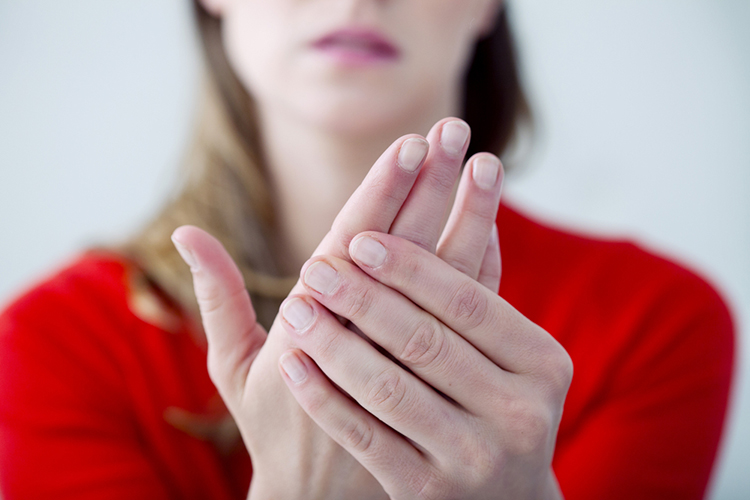
RP is mainly controlled pharmacologically by drugs like prazosin and nifedipine. A sympathectomy (sympathetic nerve lesion) may be performed in severe cases. Unfortunately, symptom improvement is limited to 1-2 years.
Physicians divide Raynaud’s phenomenon (RP) into primary and secondary RP (Wigley & Flavahan, 2016). Primary RP is not due to an identifiable disorder. Secondary RP is caused by observable processes like trauma (carpal tunnel syndrome and shoulder girdle compression syndrome), arterial disorders (atherosclerosis), and rheumatic disorders (lupus erythematosus; Spittell, 1972).
Demographics
The prevalence of RP ranges between 3-5%, and Raynaud's is more frequently diagnosed in women and younger patients. Primary RP accounts for more than 80% of Raynaud's cases. Between 15-20% of primary RP patients later develop a significant systemic disease (Hallett, 2014).Diagnosis
Physicians usually diagnose RP using Allen and Brown’s (1932) criteria of bilateral color change due to cold or emotion, absence of severe gangrene and primary systemic disorders that could produce RP symptoms, and a symptom history of over two years.Pathophysiology
The pathogenesis of RP is a complex interplay of mechanisms, transcending the simplistic division between sympathetic nervous system overactivity and intrinsic vascular dysfunction (Herrick, 2012; Wigley & Flavahan, 2016).The dual defect model posits that cold both increases sympathetic outflow and primes local a2-ARs, creating a permissive environment for vasospasm (Kahalek & Matucci-Cerinic, 2020). In primary RP, the local fault hypothesis is most prominent. This form of the condition is largely driven by hypersensitivity of a2C-adrenergic receptors, which become activated during cold exposure. Cooling triggers the movement (translocation) of these receptors to the vascular smooth muscle cell membrane, amplifying vasoconstriction even under mild conditions. This receptor-level dysfunction explains why vasospastic episodes can occur independently of systemic sympathetic input.
In contrast, secondary RP incorporates both local vascular abnormalities and heightened sympathetic activity. Structural vascular damage, such as intimal fibrosis or endothelial dysfunction, reduces arterial compliance and predisposes blood vessels to collapse during vasoconstrictive stimuli. Autoimmune conditions, such as scleroderma, further exacerbate this by impairing nitric oxide-mediated vasodilation and promoting a pro-constrictive environment. In this context, sympathetic hyperactivity plays a more significant role, as stress-induced surges in norepinephrine can easily overwhelm already compromised vasculature.
Click on the Read More button to learn more about RP pathophysiology.

The triggers for Raynaud’s attacks also reflect this dual mechanism. Cold exposure primarily exacerbates the local fault by activating a2C-adrenergic receptors through signaling (reactive oxygen species and Rho kinase) pathways. On the other hand, emotional stress engages central sympathetic pathways via hypothalamic-pituitary-adrenal axis activation, leading to increased circulating catecholamines. While primary RP patients lack systemic sympathetic hyperactivity, their hypersensitive adrenergic receptors amplify even minor norepinephrine surges, making them prone to stress-induced attacks.
Understanding these mechanisms has significant therapeutic implications. Treatments targeting the local fault include calcium channel blockers to reduce vascular smooth muscle contraction and topical nitrates to enhance nitric oxide-dependent vasodilation.
Emerging therapies such as Rho kinase inhibitors aim to block the translocation of a2C-adrenergic receptors, addressing the root cause of cold-induced vasospasm (Kahalek & Matucci-Cerinic, 2020). For cases where sympathetic overactivity plays a larger role, a-adrenergic antagonists can mitigate excessive vasoconstriction, although their use is limited by systemic side effects like hypotension. Sympathectomy has been employed in some cases but offers only temporary relief and fails to address locally mediated mechanisms.
Ultimately, a unifying model for RP must account for both local and systemic contributions to its pathophysiology. In primary RP, intrinsic vascular hypersensitivity dominates, while secondary RP integrates structural damage and dysregulated sympathetic activity.
Cold exposure amplifies receptor-level dysfunction in both forms of the disease, whereas emotional stress primarily engages central nervous system pathways. Future therapeutic strategies may benefit from combining approaches that target a2C-adrenergic receptor dysfunction with agents that protect endothelial integrity, offering a more comprehensive solution to this multifaceted disorder.
RP Treatment Protocols
Successful RP training protocols may modify patients’ resistance vessel response to cold and cold-related stimuli resulting in increased capillary blood flow.Guglielmi, Roberts, and Patterson (1982) reported that temperature biofeedback, SEMG biofeedback, and a control condition produced comparable symptom reductions in their double-blind study.
Freedman and Ianni (1983) compared temperature biofeedback with autogenic training, SEMG biofeedback, and instructions to raise temperature. Only subjects receiving temperature biofeedback achieved significant temperature increases during the first 12 minutes. These increases did not involve relaxation on heart rate, respiration rate, frontalis SEMG, or skin conductance measures.
Consistent finger temperature increases during training were necessary for response generalization to the environment. Their results suggested that training sessions should be limited to 16 minutes and that 10 sessions produced no more significant finger temperature increase than 6 sessions.
Freedman, Ianni, and Wenig (1983) compared the efficacy of finger temperature biofeedback, finger temperature biofeedback under cold stress, frontalis SEMG biofeedback, and autogenic training with RP patients.
Both temperature groups increased finger temperature without evidence of relaxation. The frontalis SEMG biofeedback and autogenic training groups did not increase finger temperature but reduced muscle tension and self-reported stress.
At 1-year follow-up, the finger temperature biofeedback under cold stress group showed higher voluntary finger temperatures during voluntary control and cold stress than the finger-temperature biofeedback only group. While 24-hour measurements of tonic blood flow showed no change, both temperature groups required lower temperatures to trigger vasospastic attacks.
RP patients who received temperature biofeedback under cold challenge produced superior symptom reduction (92.5%) than temperature (66.8%), autogenic training (32.6%), or frontal SEMG (17%) patients. Cognitive stress management training, which was provided to half of the subjects in each condition, had no significant effect. Reductions in attack frequency were maintained at a 3-year follow-up (Freedman, lanni, & Wenig, 1985).
Freedman (1991) demonstrated that different mechanisms are responsible for vasodilation and vasoconstriction produced by temperature biofeedback.
Vasodilation in normals and secondary RP patients is due to a beta-adrenergic vasodilating mechanism instead of reducing the firing of sympathetic digital nerves. Temperature elevations in RP patients are not associated with changes in norepinephrine or epinephrine. Slight elevations in heart rate, skin conductance level, and systolic and diastolic blood pressures were found. Vasoconstriction in normals is mediated by efferent, sympathetic fibers.
Implications for Temperature Biofeedback
Freedman and colleagues' research has profound implications for temperature biofeedback.First, patients should be trained to vasodilate and vasoconstrict since they are different skills involving separate mechanisms. Training in both skills may teach more effective thermoregulation.
Second, temperature biofeedback should not be used alone as a general relaxation procedure. It did not produce relaxation on heart rate, respiration rate, frontalis SEMG, or skin conductance measures in normals.
Third, the best length of a temperature biofeedback training session warrants further study. While Taub found that sessions longer than 16 minutes produced diminishing returns for RP clients, this may depend on the population trained, biofeedback protocol used, therapist skill, and individual differences in the ability to learn to self-regulate.
Sedlacek and Taub (1996) concluded in their literature review that 80-90% of Raynaud’s disease patients could achieve significant improvement with 10-20 biofeedback treatments over 3-6 months, with several follow-up sessions over the next few years. Failure to provide the most effective office treatment and assign home temperature training may produce results no better than verbal relaxation training, autogenic training, or medication (reducing vasospastic attacks in 10-40% of Raynaud’s patients).
The Raynaud's Treatment Study Investigators (2000) examined 313 primary Raynaud's patients and reported that nifedipine, a calcium-channel blocker, produced more signficiant symptom reduction than thermal biofeedback, SEMG biofeedback, and placebo.
Middaugh and colleagues (2001) reported the results of the multicenter Raynaud’s Treatment Study that compared the efficacy of these treatments:
- digital skin temperature biofeedback
- frontal SEMG biofeedback
- nifedipine-XL
- medication placebo
Karavidas, Tsai, Yucha, McGrady, and Lehrer (2006) reviewed 8 randomized controlled trials (RCTs) and two follow-up studies of temperature biofeedback (TBF) for primary Raynaud's disease. They rated temperature biofeedback for primary Raynaud's disease as "efficacious" because three small independently conducted RCTs provided evidence for the “superiority or equivalence” of treatments that incorporated TBF. A large study that achieved negative outcomes did not successfully train subjects to warm their hands.
The authors proposed the following treatment guidelines for primary Raynaud's disease:
"1. Subjects should be trained to a predetermined criterion (i.e., voluntarily raising temperature to 93° F (33.9° C) for at least 15 minutes [Sedlacek, 1979]) to ensure the acquisition of the specific vasodilation response.
2. Include cold stress conditions in the training.
3. Include a no feedback session to facilitate the transfer of skills outside the laboratory.
4. Include home practice and applied practice in the natural environment.
5. Consider a multiple treatment approach.
6. Address anxiety and comorbid emotional disorders that may complicate treatment." (pp. 214-215).
Sporbeck et al. (2012) conducted a randomized controlled trial on Raynaud's phenomenon (RP) due to systemic sclerosis that compared deep oscillation, biofeedback, and a wait-list control group. Biofeedback significantly reduced visual analog pain scores.
Clinical Efficacy
Based on eight RCTs, Fred Shaffer and Zachary Meehan (2023) rated biofeedback for RP as level 4 - efficacious in Evidence-Based Practice in Biofeedback and Neurofeedback (4th ed.). TBF will not reduce the frequency of Raynaud's attacks unless patients learn to increase hand temperature (Yucha, 2016),Low Back Pain
Clinicians classify low back pain as chronic after 3 months since connective tissue usually heals within 6-12 weeks (Wheeler, 2014). While more than 95% of low back pain cases are acute and improve within 1 to 3 months of therapy, under 5% of cases are chronic and do not resolve within 6 months (Sella, 2003).
Chronic low back pain may involve paravertebral muscle misuse causing ligament strain, muscle tear, spinal facet injury, disk prolapse (protrusion), and psychological processes.
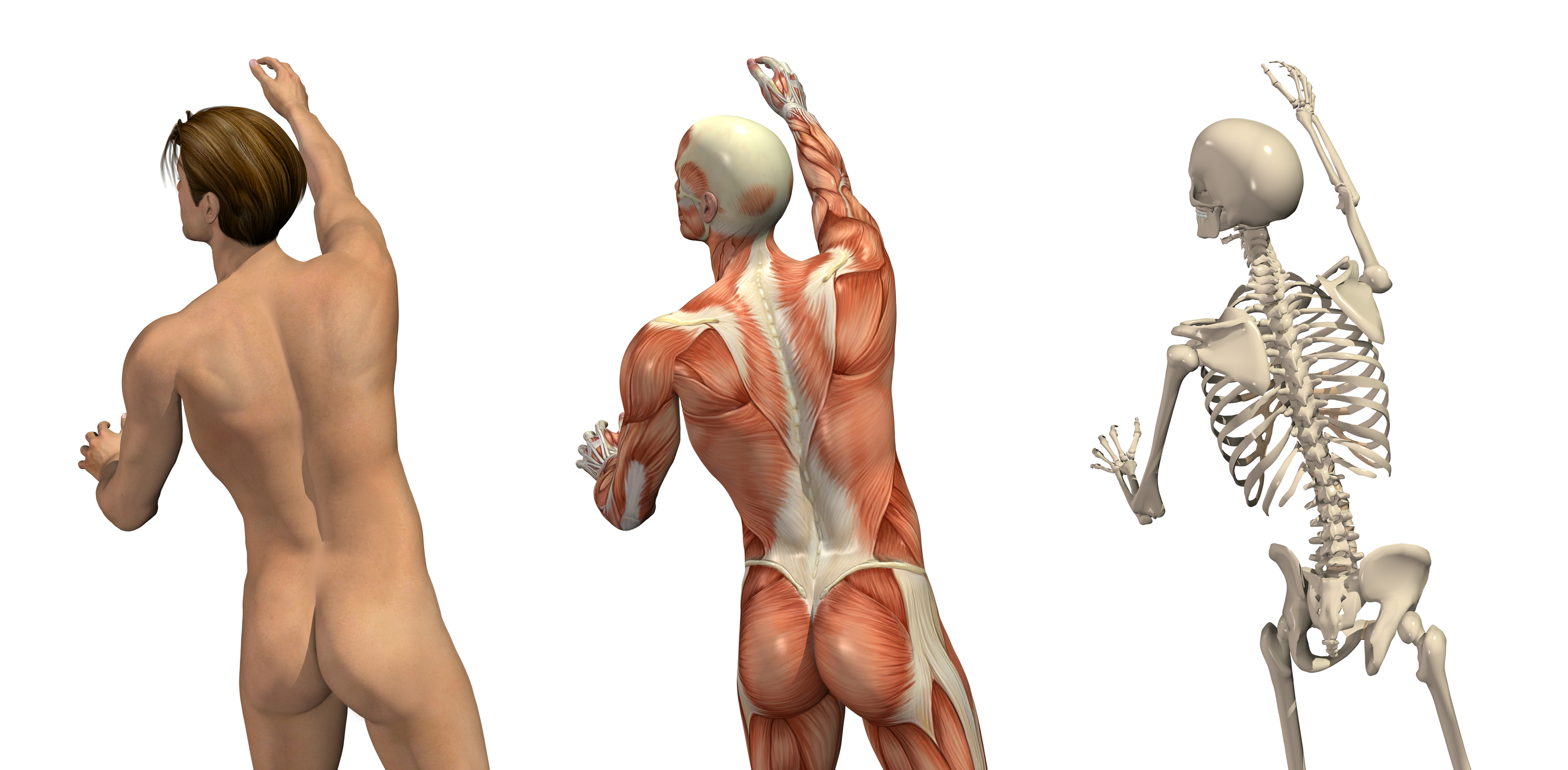
Clinicians often observe a cycle of injury, protective bracing, and chronic contraction that produces muscle asymmetry and a restricted range of motion.
Listen to a mini-lecture on Low Back Pain Overview © BioSource Software LLC. Graphic © Olly y/Shutterstock.com.
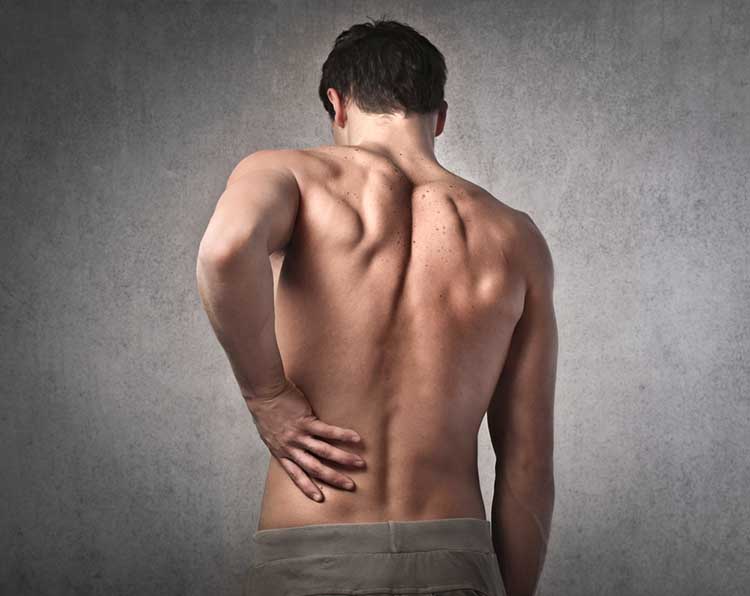
Apkarian and colleagues (2004) reported that chronic low back pain could produce atrophy of the prefrontal cortex and impair judgment on the Iowa Gambling Test.
Demographics
About 80% of Americans suffer low back pain during their lifetime. Low back pain temporarily disables 3-4% and permanently disables 1% of working-age Americans. The annual prevalence of low back pain in the United States is 15-20%. Low back pain ranks behind colds as a cause of lost work hours and accounts for 19% of Workers' compensation claims. While men and women report comparable rates of low back pain, women report this disorder more frequently than men after age 60 (Wheeler, 2014).Spinal Nerves
The spinal cord is divided into 31 pairs of spinal nerves that arise at regular intervals.
- cervical nerves (C1-C8) in the neck region
- thoracic nerves (T1-T12) in the chest region
- lumbar nerves (L1-L5) in the lower back region
- sacral nerves (S1-S5) at the sacrum
- coccygeal nerves (1 pair) near the coccyx
The Anatomy of Thoracic, Lumbar, and Sacral Spine-Associated Muscles
The muscles that move the vertebral column (backbone) have diverse origins and insertions, extend in different directions, and are layered on top of each other. The muscles of primary interest include the trapezius in the upper back and the lower back's erector spinae.
The trapezius, the most superficial back muscle, is a triangular muscle sheet covering the posterior neck and superior trunk. The two trapezius muscles form a trapezoid. The upper trapezius elevates the scapula (shoulder blade) and helps extend the head.
The erector spinae, the largest back muscle, is located on both sides of the spine and consists of three muscle groups: iliocostalis group (iliocostalis cervicis, iliocostalis thoracic, and iliocostalis lumborum), longissimus group (longissimus capitis, longissimus cervicis, and longissimus thoracis), and spinalis group (spinalis capitis, spinalis cervicis, and spinalis thoracis.
The erector spinae is the primary muscle that extends the vertebral column and plays an essential role in its flexion, lateral flexion, and rotation. Place SEMG electrodes vertically just above the iliac crest (top of the pelvic girdle) 3 centimeters from both sides of the spine for an erector spinae (L3 paraspinal) placement.
SEMG Assessment
Geisser et al. (2005) conducted a meta-analysis of 44 articles that compared patients diagnosed with low back pain (LBP) and healthy controls. For static assessment, standing produced the largest effect size. LBP subjects had higher paraspinal SEMG amplitudes.For dynamic assessment, flexion-relaxation discriminated best between subjects with LBP and normals.

Flexion-relaxation produced a very large effect size, and LBP subjects demonstrated deficient paraspinal SEMG relaxation during terminal flexion. Re-extension after full flexion produced a large effect size. Trunk rotation yielded a moderate-to-large effect size. SEMG assessment during isometric exercise and recovery after exercise yielded inconsistent results.
The paraspinal muscles (see the thoraco-lumbar fascia) are shown below in the graphic © design36/Shutterstock.com.
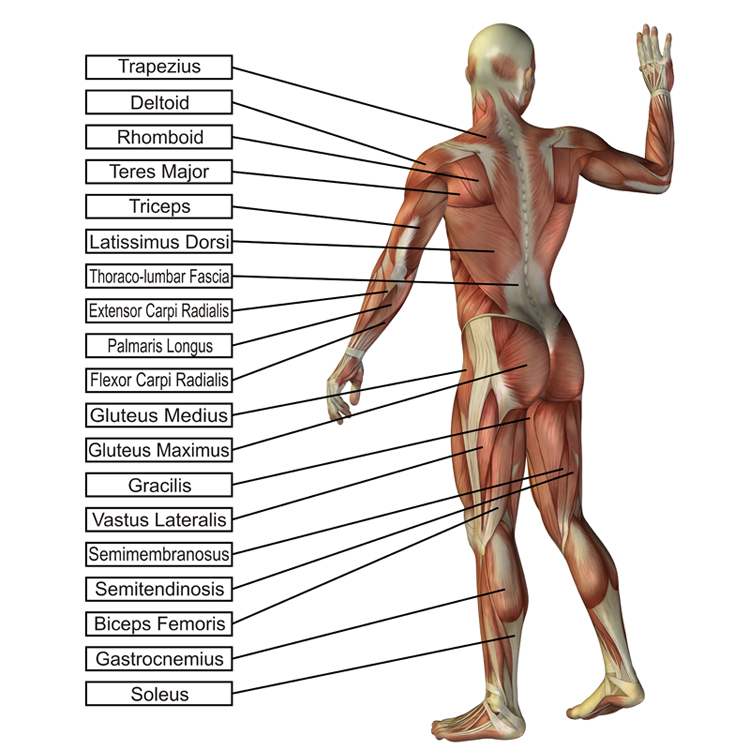
A paraspinal muscle active electrode placement is shown below.
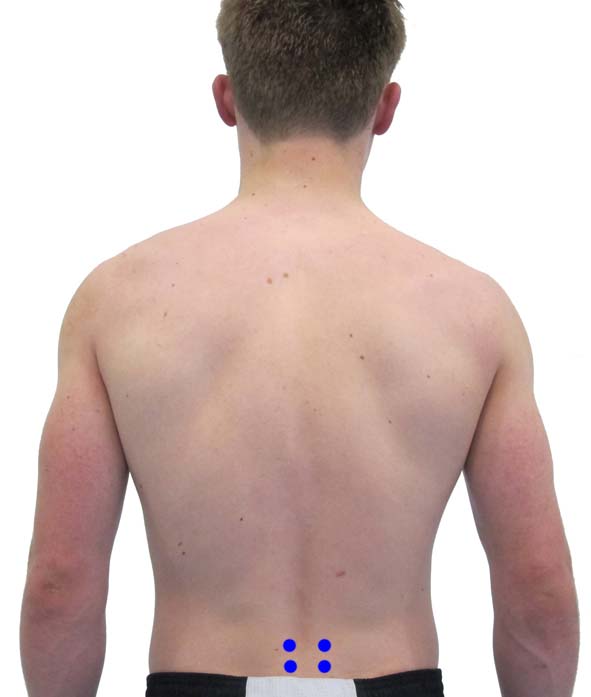
Assessing patients across diverse positions increases the chance of detecting elevated and asymmetrical patterns of muscle use. The scan may be more revealing if the patient experiences low back pain on the day of the scan. Pay special attention to asymmetries, which may be more closely associated with pain than overall SEMG levels.
A BioGraph ® Infiniti two-channel SEMG assessment of a client diagnosed with chronic low back is shown below. The blue and yellow traces represented left and right paraspinal activity, respectively. He was monitored during
Paraspinal SEMG measurements are profoundly influenced by posture. An anatomically neutral position should create symmetrical SEMG patterns within a relaxed range. In contrast, rotation to one side should produce asymmetrical SEMG patterns. A consistent rule is that symmetrical movements produce symmetrical SEMG patterns, and asymmetrical movements yield asymmetrical SEMG patterns. The side opposite to the rotation usually has higher readings. A 20% difference between left and right paraspinal SEMG values during static postures and symmetrical movements is considered clinically significant (Donaldson & Donaldson, 1990).
Neutral Standing Posture
There was a significant paraspinal elevation and asymmetry during standing in a neutral posture.
Standing Forward Flexion and Extension
During flexion, SEMG rose as the patient started to bend forward and then decreased. He was unable to relax both paraspinal muscle groups completely, and the imbalance persisted. He repeated forward flexion and extension twice.
In healthy individuals, paraspinal SEMG activity should approach 0 μV during the last 45 degrees of forward flexion as the upper torso hangs, supported by ligaments, and muscle contraction is not required (Cram, 2011). Failure to completely relax muscles following their contraction is an essential mechanism in musculoskeletal pain disorders (Neblett, 2002).
SEMG Feedback for Standing Left-Right Asymmetry
The patient successfully used SEMG biofeedback to down-train the paraspinal muscles and reduce standing asymmetry. The roller coaster accelerated as imbalance remained below a threshold value.
Complementary Medical Procedures
Click on the Read More button to see complementary medical procedures.
Complementary medical procedures to reduce muscle spasticity and strengthen weak muscles include:
- heat packs and diathermy
- ice packs
- massage
- muscle relaxants like Zanaflex (Tizanidine)
- physical therapy exercises to increase range of motion
- training to strengthen weak antigravity muscles
- Transcutaneous Electrical Nerve Stimulation (TENS)
- electrical muscle stimulation (EMS)
TENS may reduce pain by stimulating endogenous opioid release. EMS places sensors on major muscle groups to stimulate and strengthen muscles. TENS graphic © Microgen/Shutterstock.com and EMS graphic © Aleksandr Grechanyuk/Shutterstock.com.
TENS
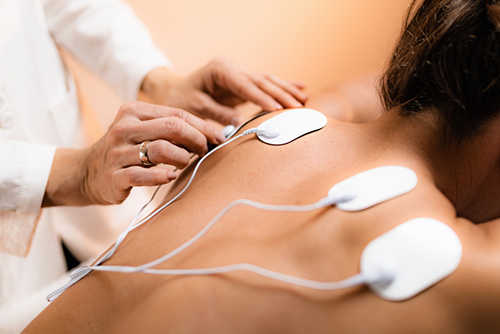
EMS
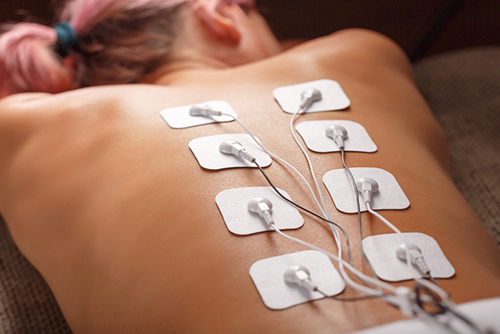
Biofeedback Treatment Protocols
A clinician may modify patient body mechanics like posture, teach muscle discrimination (since this is often deficient in chronic pain patients), incorporate strengthening and stretching exercises (paravertebral muscles, hamstrings, and hip flexors), recommend appropriate weight-lifting, and provide left and right side paraspinal SEMG biofeedback during standing and movement.Listen to a mini-lecture on Low Back Pain Treatment © BioSource Software LLC.
Neblett (2002) advocates combining active SEMG training in which a clinician combines neuromuscular re-education with general relaxation. Active SEMG training is a collaborative process that involves continuous dialog between the clinician and client. They share SEMG biofeedback and the client's self-reports to identify patterns of muscle bracing associated with pain and restricted range of motion. Finally, they evaluate strategies to correct these problems.

Several assumptions underlie active SEMG training:
- Poor posture can create muscle tension in all spinal muscles from the neck to the low back.
- Muscles should relax after they perform work.
- Continuous muscle bracing can become an unconscious habit that generates or worsens pain.
- Chronic pain patients often have limited awareness of their muscle tension and require muscle tension discrimination training.
- Chronic pain patients often show poor recovery to baseline SEMG levels following muscle contraction and require contraction/recovery training.
- Muscle training in several postural positions may be required since muscle relaxation skills often do not automatically generalize from one position (sitting) to another (standing).
- SEMG training should be bilateral to correct SEMG asymmetry.

A clinician usually conducts active SEMG training with the client's eyes open, in comon postures (like sitting upright in a straight-backed chair), during a client's typical activities (like typing on a computer keyboard), across a range of movements (including standing, bending, and walking).
A client's treatment plan is based on multi-channel SEMG assessment during activities like sitting, standing, bending, turning to one side and walking. A clinician examines client performance for elevated SEMG values, speed, and completeness of recovery following contraction (like bending forward and returning to an upright position), co-contraction, and asymmetry.
Muscle co-contraction occurs when SEMG levels in one muscle increase from baseline during the contraction of another muscle. For example, when head rotation increases vastus medialis SEMG activity (Donaldson et al., 2002).
Steven Wolf has proposed two rules regarding symmetry and asymmetry in non-pain and pain subjects (Cram, 1988). A typical symmetrical movement is flexion/extension of the waist (Donaldson & Donaldson, 1990).
Rule 1: "In non-pain subjects, symmetrical movement produces symmetrical patterns."
Rule 2: "In pain patients, symmetrical movement produces asymmetrical patterns."
An imbalance of 5-10% during movement is typically observed in non-pain subjects. Donaldson measures the imbalance at maximum contraction by subtracting SEMG values from two opposite sides. These measurements strongly correlate (r = .61) with pain reports (Donaldson, 1989).
Pathological asymmetry is present when there is at least a 20% difference between left and right muscle groups (Donaldson & Donaldson, 1990). Two patterns of SEMG asymmetry are splinting and protective guarding. Splinting involves SEMG elevation on the injured side of the body. Protective guarding is a SEMG elevation on the side opposite an injury.
When the body is correctly aligned with balanced weight-bearing, it can maintain an upright posture while allowing antigravity muscles to relax. Chronic pain can result in asymmetrical postural adjustments, and asymmetrical posture can, in turn, overload joints and muscles and worsen pain (Middaugh, Kee, & Nicholson, 1994; Neblett, 2002b).
Sherman (2004) has proposed a five percent rule that severe acute pain can develop and progress to chronic pain when:
- limbs deviate five degrees from a healthy position
- muscles are five percent tenser than required
- muscles remain minimally tense five percent longer than required
A clinician often integrates postural and recovery training during musculoskeletal interventions. When a client sits or stands, restoring postural balance allows the antigravity muscles to relax. After performing a movement, the restoration of postural balance makes muscle recovery possible (Neblett, 2000b).
SEMG biofeedback training for low back pain should prioritize reducing muscle spasticity. This requires down-training the paraspinal muscles and restoring left-right symmetry. A patient's pain will often lessen when SEMG voltages are reduced below 5 μV and balanced within 5%.
Two-channel SEMG training should reduce muscle spasticity and co-contraction, increase awareness of muscle tension, and restore muscle symmetry (during neutral posture) and flexion-relaxation. Since chronic pain patients are often unable to return to baseline SEMG levels after muscle contraction quickly, recovery training may be crucial to their improvement. Active SEMG training requires a detailed understanding of muscle action. For example, following a shoulder injury, a client may present with scapular winging (protrusion of the shoulder blade) and pain during flexion. Treatment may require up-training the lower trapezius, which depresses the scapula, and down-training the upper trapezius, which elevates the scapula (Neblett, 2006).SEMG biofeedback-assisted therapy appears to be comparable to cognitive therapy and superior to a wait-list control (Newton-John, Spence, & Schotte, 1995; Vlaeyan and colleagues, 1995).
Newton-John, Spence, and Schotte (1995) compared SEMG biofeedback and cognitive therapy against a wait-list control. Both treatments produced comparable improvement that was maintained at 6-months follow-up, and these treatments were superior to the wait-list control.
Vlaeyan and colleagues (1995) compared SEMG biofeedback and cognitive training against a wait-list control and operant conditioning for 71 chronic back pain patients. SEMG biofeedback and cognitive training produced equivalent outcomes superior to a wait-list control and operant conditioning.
Sella (2003) argues that combining SEMG biofeedback with traditional medical and physical therapy is a pragmatic and cost-effective approach because it shortens treatment (usually to 3 months), teaches muscle self-regulation, and reduces dysfunctional muscle use and resulting pain.
Clinical Efficacy
Based on four RCTs, Saul Rosenthal rated biofeedback for low back pain as level 4 - efficacious in Evidence-Based Practice in Biofeedback and Neurofeedback (4th ed.).Clinicians trained clients to reduce SEMG and stabilize the trunk and relax (BART). Participants improved on depression, distress, pain intensity, disability, pain cognitions, and muscle activation.
Myofascial Pain
Chronic myofascial pain syndrome is a regional pain disorder characterized by trigger points, which are hyperirritable regions of taut bands of skeletal muscle in the muscle belly or associated fascia (connective tissue). Pressure on trigger points is painful. Trigger points can produce referred (remote) pain and tenderness, motor dysfunction, and autonomic changes. Graphic © Alila Medical MediaShutterstock.com.
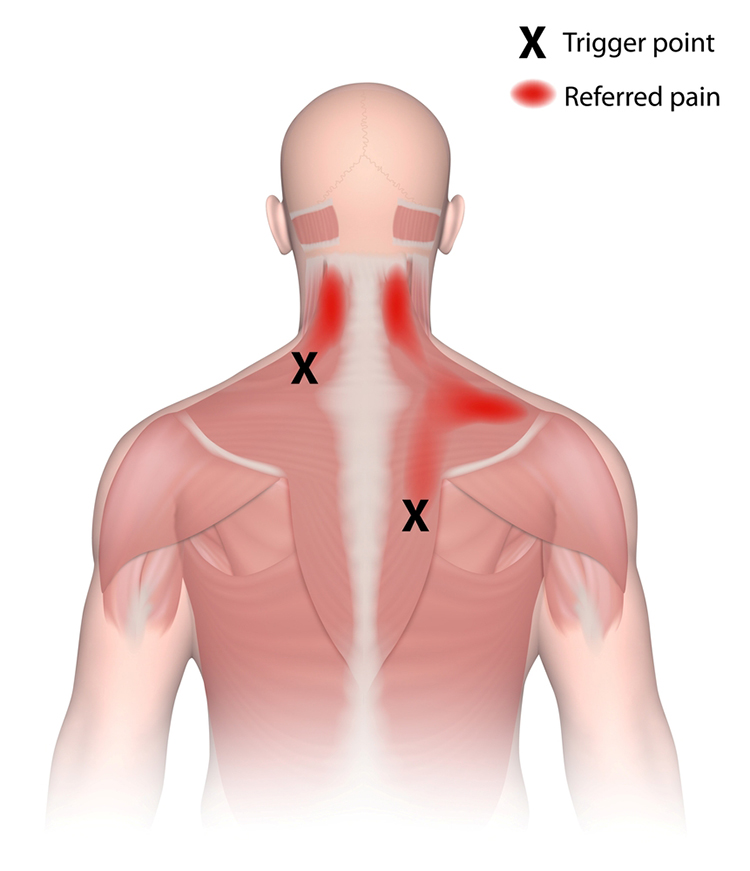
Trigger points cannot be detected using SEMG electrodes but can be identified using needle EMG electrodes and palpation (examination by feeling or pressing with the hand). Graphic © saap585/Shutterstock.com.
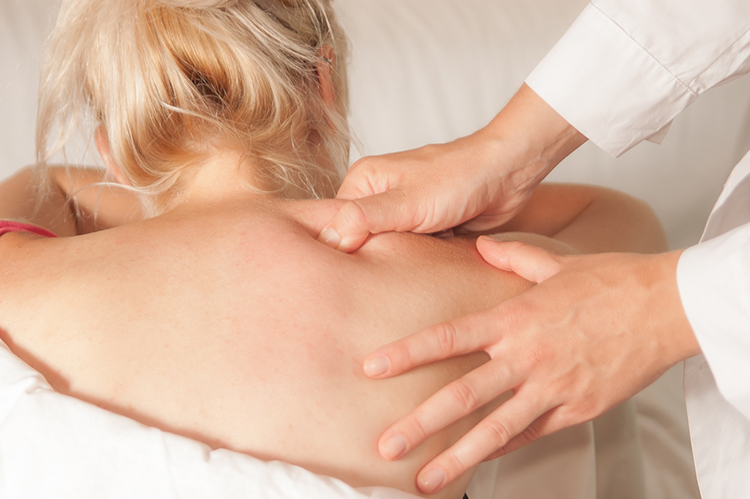
Increased sympathetic efferent signals to muscle spindles and overexertion can produce a spasm in the muscle spindle's intrafusal fibers, increasing muscle spindle capsule pressure and causing myofascial pain.
Demographics
About 14.4% of the United States population experiences chronic musculoskeletal pain. Almost everyone develops a trigger point during their lives. About 21-93% of patients diagnosed with regional pain complaints present with myofascial pain. This syndrome is equally distributed between men and women. Trigger points can be found in patients of all ages, including infants. Sedentary individuals have a higher risk of developing trigger points than individuals who daily engage in vigorous activity (Finley, 2013).Anatomy and Physiology
Hubbard and Gevirtz have proposed that sympathetically-mediated muscle spindle spasm may be the essential local mechanism in myofascial pain.
Sympathetic innervation of human muscle spindles has been demonstrated through the presence of neuropeptide Y (NPY), NPY receptors, and tyrosine hydroxylase (TH) on intrafusal fibers and associated blood vessels, indicating direct sympathetic input beyond just the vascular supply (Radovanovic et al., 2015).
This sympathetic influence on muscle spindles has significant implications for understanding trigger points, muscle spasticity, and pain. Trigger points, defined as hyperirritable spots within taut bands of skeletal muscle, often exhibit increased muscle spindle sensitivity and spontaneous electrical activity (Gerwin et al., 1997). The heightened sympathetic drive—whether from stress, chronic pain, or systemic dysfunction—could exacerbate this sensitivity, contributing to sustained muscle contraction and local ischemia. This ischemia can further sensitize nociceptors, perpetuating a cycle of pain and increased muscle tone.
In muscle spasticity, typically observed in conditions like stroke or spinal cord injury, altered proprioceptive feedback through hyperactive spindles may contribute to exaggerated stretch reflexes. Sympathetic overactivity could worsen this by increasing spindle excitability, thereby enhancing muscle stiffness and reducing motor control (Dietz, 2002). Additionally, chronic sympathetic activation in conditions such as complex regional pain syndrome (CRPS) is associated with muscle hyperalgesia, potentially mediated by exaggerated spindle activity and increased afferent input to the central nervous system (Wasner et al., 2003).
Gevirtz's (2003) mediational model of muscle pain proposes that lack of assertiveness and resultant worry each trigger sympathetic activation. Graphic © Photographee.eu/Shutterstock.com.


Gevirtz (2013) hypothesizes that HRVB improvement in autonomic balance may interfere with SNS innervation of trigger points through the mechanism of accentuated antagonism (Olshansky, Sabbah, Hauptman, & Colucci, 2008).
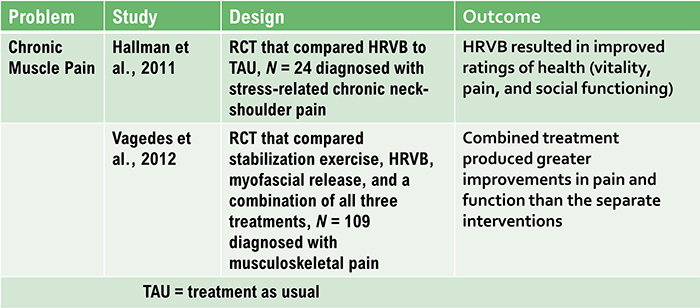
Clinical Efficacy
Sherman, Tan, and Wei (2016) rated biofeedback for myofascial pain syndrome as level 2 - possibly efficacious in Evidence-Based Practice in Biofeedback and Neurofeedback (3rd ed.).Fibromyalgia (FM)
Fibromyalgia (FM) is a chronic benign pain disorder that involves pain, tenderness, and stiffness in the connective tissue of muscles, tendons, ligaments, and adjacent soft tissue. Graphic © medicalstocks/Shutterstock.com.
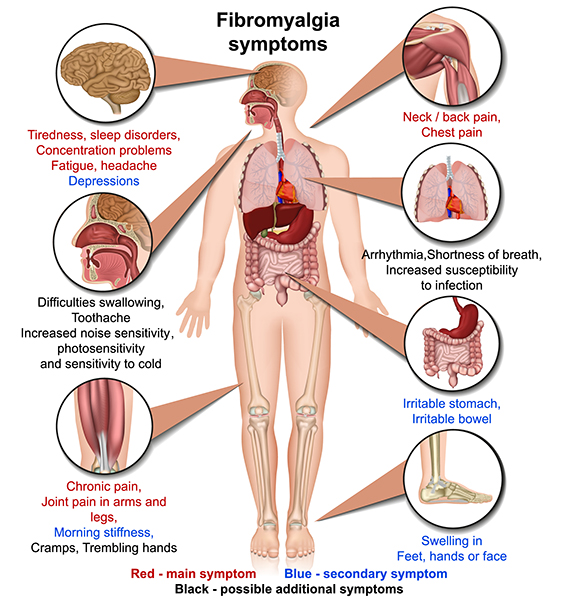

The American College of Rheumatology (ACR) adult criteria include widespread pain for at least 3 months on both sides of the body and pain during gentle palpation on 11 of 18 tender points on the neck, shoulder, chest, back, arm, hip, and knee sites.
Patients also present with attentional deficits, depression, severe fatigue, headaches, impaired multitasking, irritable bowel syndrome, memory deficits, sleep disturbance, and temporomandibular muscle and joint pain (Donaldson & Sella, 2003; Tortora & Derrickson, 2021).
McGrady and Moss (2013) conceptualize FM as a “pain amplification disorder” produced by the twin mechanisms of allodynia and hyperalgesia (p. 187).
Allodynia means that patients experience previously benign stimuli as painful. Hyperalgesia means patients experience mildly painful stimuli as severely painful. While an initial injury that damages tissue may sensitize the body through peripheral and central sensitization, in other cases, there may be no identifiable precipitating event. Sequelae of negative emotion and sleep deprivation increase pain and impair cognitive performance. The graphic below depicts back pain in fibromyalgia.
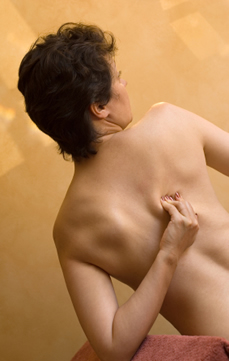
Demographics
The 2010 ACR fibromyalgia adult criteria are probably met by 7.7% of women and 4.9% of men. The female-to-male ratio is probably 4:1 due to the underestimation of its prevalence in men. While fibromyalgia is mainly seen in women 20-50 years, with average onset at 47.8 years, it is also diagnosed in adolescents and the elderly. The peak prevalence in women occurs between 60-70 years. Fibromyalgia pain typically persists 78.7 months (Donaldson & Sella, 2003; Boomershine, 2015).Anatomy and Physiology
The etiology of fibromyalgia appears to involve a central hypersensitivity to heat, cold, and electrical stimulation (Desmeules et al., 2003).
Fibromyalgia patients may have low levels of serotonin, amino acids like tryptophan, and insulin-like growth factor (IGF-1), and high levels of substance P and ACTH.
Patients present with multiple tender points, which are distinct from trigger points. Tender points are located at a muscle's insertion (the tendonous attachment to a movable bone) instead of the muscle belly or associated fascia. Graphic © Alila Medical Media/Shutterstock.com.
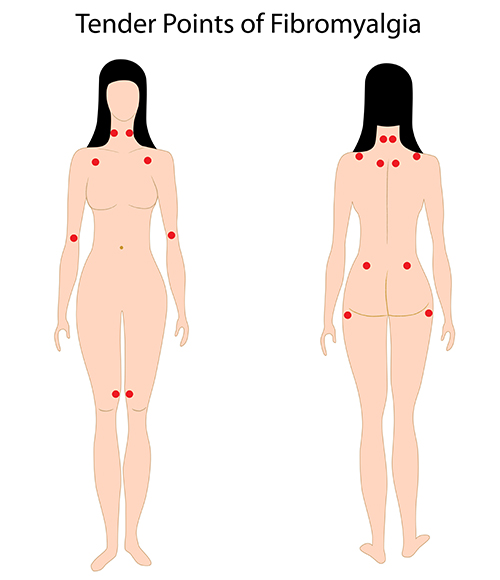
Tender points are associated with local tenderness. When compressed, they produce local pain but not the referred pain associated with trigger points. Pressure on tender points may increase overall pain sensitivity. Fibromyalgia is sometimes confused with Myofascial Pain Syndrome (MPS) because both syndromes involve muscle tenderness and local pain during palpation.
The table below was adapted from Alvarez and Rockwell (2002).

Patients may present with both fibromyalgia and MPS and have both tender points and trigger points. Accurate diagnosis requires careful examination by an experienced clinician (Alvarez & Rockwell, 2002).
Biofeedback Treatment of Fibromyalgia
At this point, there is no evidence that biofeedback is superior to other mind-body therapies. No randomized controlled trials have shown that biofeedback significantly reduces fibromyalgia symptoms when administered by itself or potentiates the effectiveness of treatments like massage therapy, physical exercise, and physical therapy.SEMG and neurofeedback have been administered with cognitive behavior therapy, hypnosis, and physical exercise. Reviews by Hadhazy, Ezzo, Creamer, and Berman (1990) and Sim and Adams (1999) found no evidence that either form of biofeedback was superior to the other mind-body therapies. Instead, a combination of mind-body therapies and exercise appeared to produce the most significant clinical gains.
A retrospective study by Donaldson, Sella, and Mueller (1998) treated subjects with a multidisciplinary program, including SEMG biofeedback, massage therapy, physiotherapy, and neurofeedback. At a 1-year follow-up of 44 program graduates, 4 reported increased symptoms, 10 reported a 100% decrease in symptoms, and 30 reported some improvement.
Mur et al. (1999) and Sarnoch, Adler, and Scholz (1997) reported on uncontrolled trials where SEMG biofeedback produced improvement by itself.
Mueller et al. (2001) reported on another uncontrolled trial where EEG-driven stimulation resulted in symptomatic improvement.
Al-Haggar, Al-Naggar, and Abel-Salam (2006) demonstrated that a combination of EMG biofeedback and cognitive behavioral therapy resulted in patient gains.
Babu, Mathew, Danda, and Prakash (2007) found that EMG biofeedback monotherapy resulted in some improvement.
Mitani et al. (2006) compared fibromyalgia patients and normals and found significant asymmetries in skin conductance levels, skin temperature, and SEMG measurements consistent with nervous system pathology. Caro and Winter (2011) reported that 40 sessions of neurofeedback resulted in significant improvement in fatigue, pain, tenderness, and visual attention compared to control patients.
Globiewski, Bernardy, and Hauser (2013) conducted a meta-analysis of seven studies with 321 patients diagnosed with fibromyalgia. SEMG biofeedback was superior to control groups in reducing pain severity. The effect size was large, and the improvement was only seen for patients who received SEMG biofeedback. Neurofeedback did not reduce pain severity. Symptoms like depression, fatigue, and sleep did not improve.
Research has included HRVB as a treatment component in addition to exercise, cognitive therapies (Acceptance and Commitment Therapy and Cognitive Behavioral Therapy), and interventions to improve sleep habits. The putative mechanism may be increased autonomic balance (Gevirtz, 2013).

Clinical Efficacy
Based on one RCT using SEMG biofeedback and two RCTs using theta/SMR neurofeedback, Christopher Gilbert (2023) rated biofeedback for fibromyalgia at level 3 - probably efficacious in Evidence-Based Practice in Biofeedback and Neurofeedback (4th ed.).
Temporomandibular Disorders (TMD)
Temporomandibular disorders (TMD) are the second most common cause of orofacial pain after toothache. Whereas TMD is a heterogeneous group of disorders, orofacial pain and/or masticatory problems may be classified as TMD secondary to myofascial pain and dysfunction (MPD), TMD secondary to articular disease, or both. TMD is characterized by dull pain around the ear, tenderness of jaw muscles, a clicking or popping noise when opening or closing the mouth, limited or abnormal opening of the mouth, headache, tooth sensitivity, and abnormal wearing of the teeth.
Listen to a mini-lecture on TMD Overview and Treatment © BioSource Software LLC.
TMD pain is located in the preauricular area, muscles used for chewing (masseter, temporalis, and pterygoids), or the temporomandibular joint. Graphic © Alex Mit/Shutterstock.com shows the masseter and the temporomandibular joint.

TMD pain is triggered by parafunctional jaw clenching, which may be unilateral or bilateral in MPD. It is reported along with headache, other facial pain, neck pain, and pain in the shoulder and back. Check out the Alila Medical Media YouTube video TMJ and Myofascial Pain Syndrome, Animation.

Glaros and Burton (2004) demonstrated that subjects without TMD, who were trained during 20-minute SEMG biofeedback sessions over 5 consecutive days to increase left and right masseter and temporalis SEMG levels, experienced increased pain at post-treatment. Pain severity was highly correlated with masseter activity. After completing training, an examiner who was blind to their clinical status diagnosed 2 SEMG-increase subjects and no SEMG-decrease subjects with TMD pain. Remember, they were pain-free when they started the experiment.
A masseter placement is shown below. Training is bilateral using two SEMG sensors to prevent imbalance between the left and right masseter muscles.
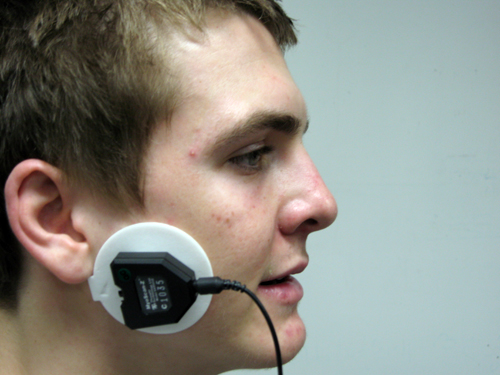
Demographics
While 5%-10% of Americans may satisfy the criteria for TMD, up to 75% of Americans will present with several of its symptoms. The male-to-female ratio is 1:4. Young adults are the highest risk group, particularly women from 20-40 years (Guardia, 2014).Joint and Muscle Anatomy of TMD
The temporomandibular joint uses a “ball and socket” mechanism as it first opens. The condyle rotates within the articular fossa. As it opens wider, the condyle translates over the articular eminence (or dislocates over a protrusion in the upper jaw).
Major muscles and their actions include:
- masseter muscles (elevate and retract the mandible)
- temporalis muscles (elevate and retract the mandible)
- lateral (external) pterygoid muscle (protracts and depresses the mandible and moves it laterally)
- medial (internal) pterygoid muscle (elevates and protracts the mandible and moves it laterally)
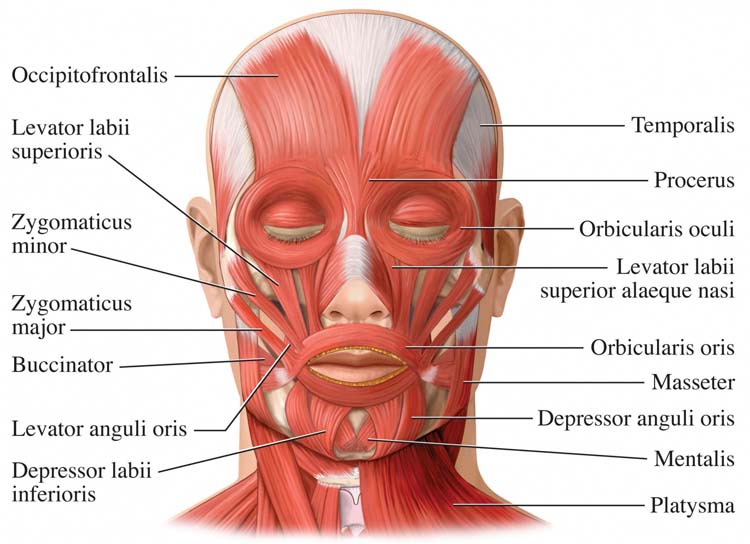
TMD patients may also have problems with the sternocleidomastoid muscles, hyoid muscles, and digastric muscles.
A patient should ideally be diagnosed by a dental professional who specializes in TMD. Suppose a dental examination reveals that excessive activity in facial and/or masticatory muscles contributes to TMD. In that case, a bilateral SEMG profile should be completed to determine which muscles should be trained. Training should be conducted bilaterally, with gradual reduction of SEMG activity in the more active and then the less active of left and right muscle sites (left and right masseter).
Biofeedback Treatment of TMD
Click on the Read More button to review biofeedback TMD studies.
Dohrmann and Laskin (1978) compared SEMG masseter biofeedback with a sham control over twelve 30-minute sessions provided over 6 weeks. Blind evaluation following nine sessions showed that 94% of the biofeedback group and 28% of the control did not need further treatment. After 1 year, 75% of the biofeedback group and 28% of the control group still did not need additional treatment.
Crockett, Foreman, Alden, and Blasberg (1986) randomly assigned 28 patients to SEMG biofeedback training combined with relaxation training, intraoral splinting combined with physical therapy, or transcutaneous electrical nerve stimulation (TENS). Each group received eight weekly 1-hour sessions and was asked to perform 30 minutes of homework each day. The SEMG biofeedback with relaxation training group was superior to the TENS group on palpation pain and daily self-reported pain severity and frequency. The SEMG biofeedback with relaxation training group was not superior to the intraoral splinting combined with the physical therapy group.
Turk, Zaki, and Rudy (1993) randomly assigned 80 patients to SEMG biofeedback with cognitive-behavioral therapy, intraoral splint, or wait-list control. The SEMG biofeedback with cognitive-behavioral therapy group received six weekly 1-hour training sessions. The intraoral splint group was instructed to wear their appliance for the first 6 weeks constantly.
The SEMG biofeedback with cognitive-behavioral therapy group was superior to the wait-list control group on pain reduction and depression from pre-treatment to post-treatment. At a 6-month follow-up, the SEMG biofeedback group showed increased pain reduction. The SEMG group was equivalent to the intraoral splint group on reducing pain severity and depression from pretreatment to post-treatment. At a 6-month follow-up, the SEMG group reported a greater reduction in depression than the intraoral splint group, which relapsed to pre-treatment values.
Crider and Glaros (1999) conducted a meta-analysis of 13 studies of SEMG biofeedback and stress management treatments of TMD. The SEMG sites were the masseter or frontalis muscles. Their main findings were:
- in five of 6 controlled trials, SEMG biofeedback treatment was superior
to no treatment or psychologic placebo for at least 1 of 3 outcome
measures
- mean effect sizes for reported pain and clinical exam outcomes were significantly larger for SEMG biofeedback than control conditions
- 69% of patients who received SEMG biofeedback treatments were classified as symptom-free or significantly improved, compared with 35% of patients who received placebo
- follow-ups from 3-24 months showed no relapse for patients who received SEMG biofeedback
- there was little evidence that combining SEMG biofeedback with stress management is superior to SEMG biofeedback alone; a single within-study showed an advantage
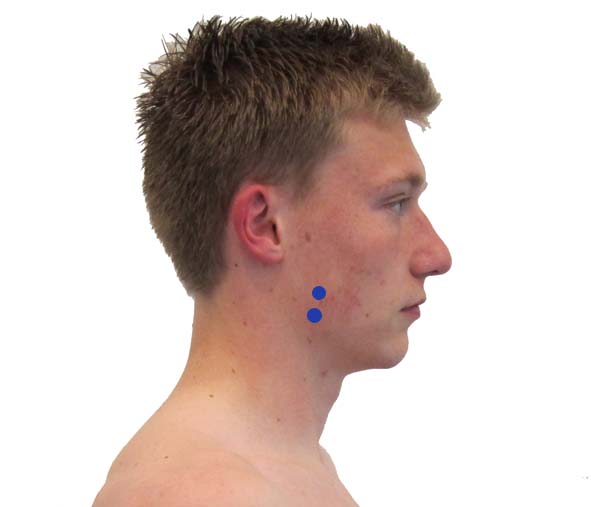
Gardea, Gatchel, and Mishra (2001) randomly assigned 108 TMD patients to biofeedback-assisted relaxation training (BART), cognitive-behavioral therapy (CBT), combined BART and CBT, or a no-treatment control group. The treatments were administered over twelve 1- to 2-hour sessions over 8 weeks. The BART condition combined relaxation training with 15 minutes of temperature and frontal SEMG biofeedback during each session.
The BART and combined BART and CBT groups achieved more significant pain reduction than the control group. The combined BART and CBT, and CBT groups achieved greater mandibular function than the control group.
Crider, Glaros, and Gevirtz (2005) reported that five randomized controlled trials of biofeedback-based treatments provided evidence of efficacy compared with controls. They concluded that SEMG training combined with cognitive-behavioral therapy is efficacious. SEMG biofeedback for the masticatory muscles and biofeedback-assisted relaxation for global relaxation are each probably efficacious. Medlicott and Harris (2006) completed a systematic review of 30 studies and recommended that clinicians combine active exercise, manual therapy, posture correction, and biofeedback-assisted relaxation to treat TMD.
Gatchel et al. (2006) conducted a randomized controlled trial of 101 patients with acute TMD-associated pain that compared CBT and frontales SEMG and temperature biofeedback with a nonintervention control. After 1 year, depression, self-rated pain, and jaw pain-related health care costs were lower for the group that received CBT combined with biofeedback (Stowell et al., 2008).
Myers (2007) found in a systematic review of TMD studies that while biofeedback was consistently superior to no-treatment and placebo controls, its efficacy compared to conventional treatments ranged from less to more effective.
Shedden et al. (2013) conducted a randomized controlled trial of 58 chronic TMD patients that compared biofeedback combined with CBT (BFB-CBT) versus treatment with an occlusal splint (OS). While both groups reduced pain intensity and disability, the BFB-CBT group coped better with pain and reported greater satisfaction. Patient gains were maintained over 6 months and were more significant for the BFB-CBT group on all measures.
Dental and Physical Therapy Approaches
Click on the Read More botton to review dental and physical therapy approaches.
Dental therapy approaches include:
- patient education
- medication (NSAIDs, muscle relaxants, and tricyclic antidepressants)
- occlusal splints
- surgery
- SEMG biofeedback
- friction massage
- ultrasonic treatment
- transcutaneous electronic nerve stimulation (TENS)
Clinical Efficacy
Based on three RCTs, Alan Glaros and Richard Ohrbach (2023) rated SEMG biofeedback for TMD pain as level 4 - efficacious in Evidence-Based Practice in Biofeedback and Neurofeedback (4th ed.).Cervical Injury
Several cervical muscles are responsible for balance and head movement. The sternocleidomastoid (SCM) muscles originate at the sternum and clavicle (collarbone) and insert at the mastoid process of the temporal bone. Graphic © design36/Shutterstock.com.
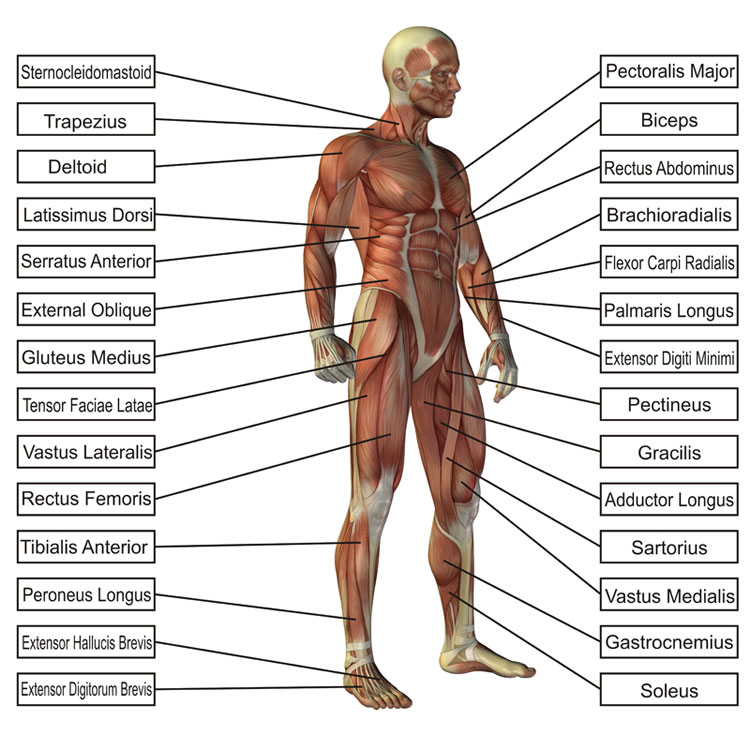

Bilateral contraction of the two sternocleidomastoid muscles flexes the cervical spine and flexes the head. Unilateral contraction of a single sternocleidomastoid muscle laterally extends and rotates the head to the opposite side. A sternocleidomastoid placement is shown below.
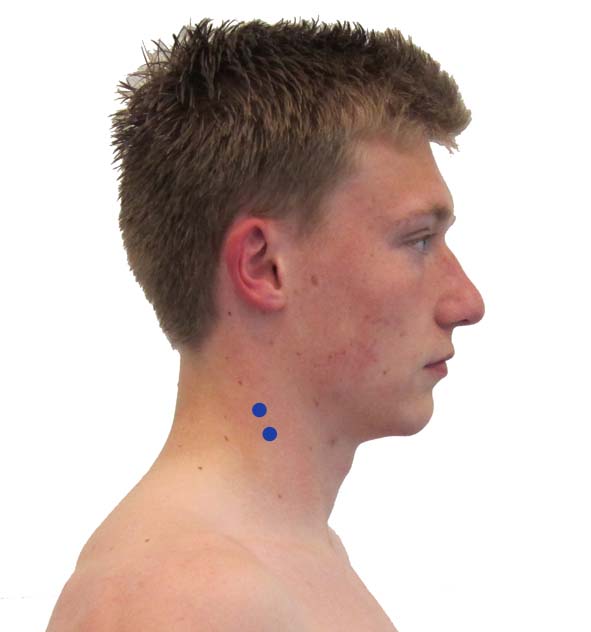
The semispinalis capitis originates in cervical and thoracic vertebrae and inserts at the occipital bone. The splenius capitis originates in cervical and thoracic vertebrae and inserts at the occipital bone and mastoid process of the temporal bone. The longissimus capitis originates in the thoracic and cervical vertebrae and inserts at the mastoid process of the temporal bone.
Bilateral contraction of the semispinalis capitis, splenius capitis, and longissimus capitis extends the head. Unilateral contraction of the semispinalis capitis rotates the head to the side opposite to the contracting muscle. Unilateral contraction of the splenius capitis and longissimus capitis turns the head to the same side as the contracting muscle.
The NeXus-10 ® BioTrace+ screen below displays bilateral sternocleidomastoid contraction during neck rotation. The right sternocleidomastoid SEMG amplitude increases, and the left decreases as the client turns his head to the left.
The neck contains the cervical segment of the spinal cord. When the vertebrae that protect the spinal cord are damaged, this can produce pain due to pressure on spinal nerves and can trigger reflex spasms in adjacent muscles that can increase the patient’s pain.
Demographics
About 85% of reported neck pain may be caused by acute or repeated neck injuries or chronic misuse. In a single year, the prevalence of neck and shoulder pain is estimated at 16-18% (Dreyer, 1998). Chronic neck pain is diagnosed in 9.5% of men and 13.5% of women (Hunter, 2014).SEMG Assessment
Medical assessment should always precede biofeedback treatment to ensure an accurate diagnosis and appropriate training. When SEMG biofeedback is medically appropriate, a clinician should begin with a two-channel SEMG assessment that includes bilateral monitoring of the cervical paraspinal and upper trapezius muscles during sitting, neutral standing, standing rotation, recovery after contraction, and walking.
Four-channel SEMG assessment is needed if the client reports restriction or pain during head rotation. In this case, the clinician needs to monitor the left/right SCM and left/right cervical paraspinal. There is a very stereotyped muscle pattern that is visible during left and right head rotation. When rotating to the left, you should see strong activation of the right SCM and moderate activation of the left cervical paraspinal. The left SCM and right paraspinal will show minimal activation. The opposite is true for rotation to the right.
One can very quickly determine whether co-contraction and inhibition are problems with cervical pain patients. If an abnormal pattern is identified, the treatment goal is to normalize it. Correcting abnormal muscle use is usually done by encouraging increased activation (up training) of the correct muscles. After patients can perform head rotation and demonstrate a more normal pattern of muscle use, they will often show an increased range of motion and report decreased pain during this movement (Neblett, 2006).
Biofeedback Treatment Protocols
A clinician should monitor four SEMG channels during dynamic training and two SEMG channels for static relaxation, postural training, and recovery training. A wide bandpass should be used unless excessive EKG artifact cannot be controlled through narrow electrode spacing. Depending upon the initial SEMG assessment results, a clinician may train the client during sitting, neutral standing, standing rotation, and walking. As with low back pain training, treatment should reduce muscle spasticity, restore muscle symmetry (during neutral posture), improve recovery to baseline SEMG levels after muscle contraction, and increase discrimination of muscle tension.Complementary Medical Procedures
Complementary medical procedures to reduce muscle spasticity and strengthen weak muscles include:- heat packs and diathermy
- ice packs
- massage
- muscle relaxants like Zanaflex (Tizanidine)
- physical therapy exercises to increase range of motion
- training to strengthen weak antigravity muscles
- Transcutaneous Electrical Nerve Stimulation (TENS)
- electrical muscle stimulation (EMS)
Clinical Efficacy
Based on four RCTs, Saul Rosenthal (2023) rated biofeedback for cervical pain as level 4 - efficacious in Evidence-Based Practice in Biofeedback and Neurofeedback (4th ed.).Worksite Ergonomic Applications
Peper and Gibney (2006) argue that it is misleading to primarily attribute pain experienced when working with a computer to repetitive movement. They propose adoption of the term computer-related disorder (CRD) because repetitive motion interacts with many other factors to produce injury and pain, including:
- limited breaks and movement
- lack of bodily awareness
- poor ergonomics
- misaligned posture
- stress experienced at home and in the workplace
- excessive physiological reactivity
- muscle overactivation in regions like the neck and shoulders
Listen to a mini-lecture on Workplace Ergonomic Applications © BioSource Software LLC.
Peper and Gibney (2006) provided the content for this Real Genius episode. Artist: Dani S@ unclebelang on Fiverr.
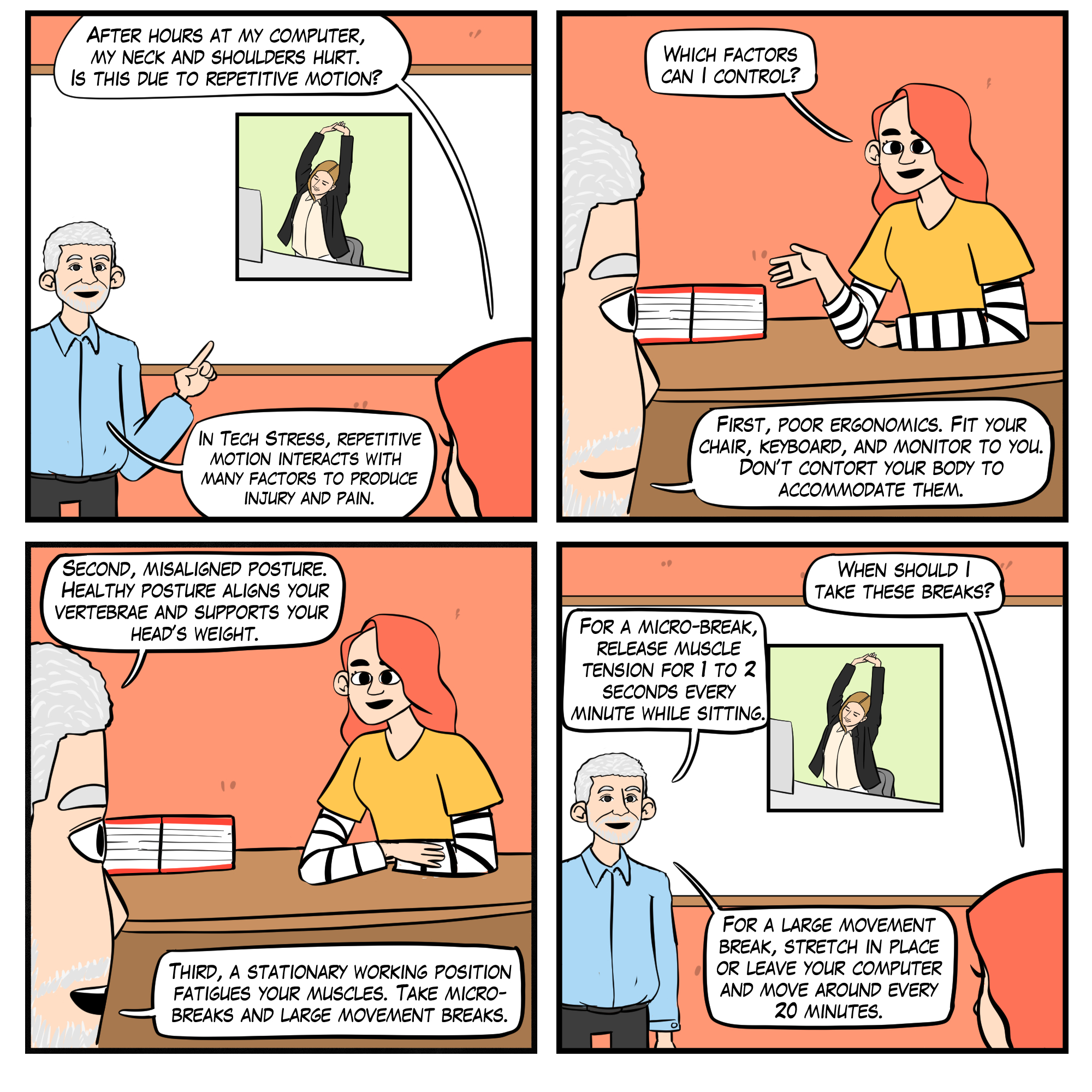
Incorrect and Correct Posture
Graphics © Sebastian Kaulitzki/Shutterstock.com.
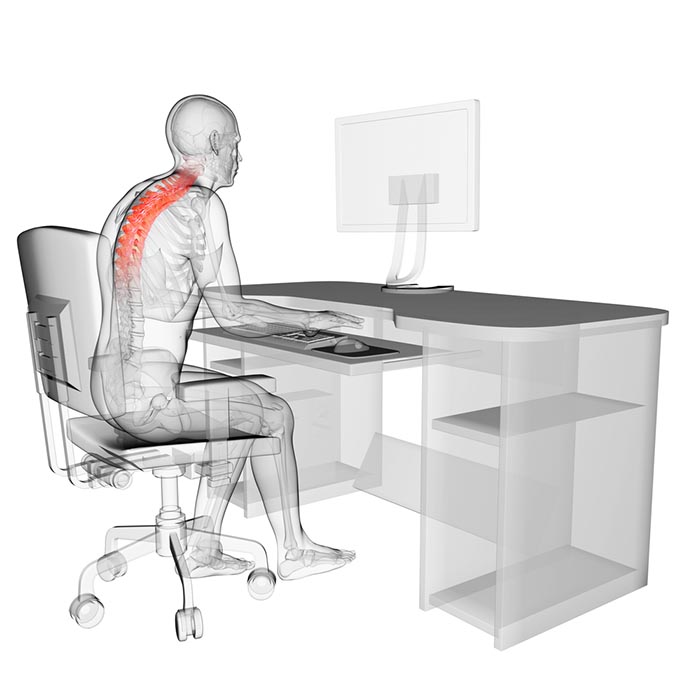

Consistent with findings in other chronic pain populations, untrained individuals lack awareness of their muscle tension and breathing pattern. They overuse their muscles and breathe thoracically.

Shumay and Peper (1995) monitored trapezius, deltoid, and forearm muscle SEMG while participants worked at varying distances from the keyboard. The three standard electrode placements below are from Peper and Gibney (2005).

They obtained shoulder tension ratings at each keyboard position and found that shoulder tension ratings were not correlated with trapezius and deltoid SEMG. They concluded that since their subjects lacked awareness of small increases and decreases in muscle tension, they could not voluntarily reduce muscle tension, even with an optimal ergonomic setup. The graphic below is courtesy of Peper and Gibney (2005).
A representative recording of a person working at the computer is shown above. Note how trapezius-deltoid and forearm extensor muscle tension increases without micro-breaks. Also, observe the increase in respiration rate. Yet, the person is unaware of these significant physiological changes.
Healthy Computing
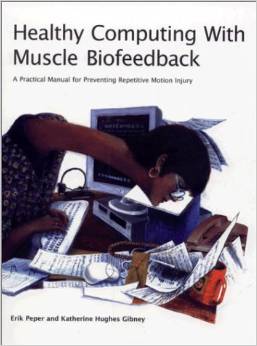
Healthy computing represents a systems approach to treating CRD. The eight components of healthy computing include:
- Work style: adopting healthy work habits. These practices include micro-breaks, large movement breaks, and pacing workflow
- Ergonomics: adjusting the workspace and hardware to facilitate healthy posture and movement
- Somatic awareness: developing awareness of muscle tension and physiological reactivity and learning how to physically, cognitively, and emotionally let go
- Stress management: learning skills to effectively cope with unavoidable stressors at home and at work in ways that promote health
- Regeneration: learning skills like meditation to recover from stress to prevent burnout and illness
- Vision care: preventing eye strain and dryness through the use of appropriate prescription glasses, ergonomic monitor position, vision breaks, and glare reduction
- Fitness: regular stretching, muscle strengthening, and movement practice to avoid injury while working at the computer
- Positive workstyle: Social support reduces arousal, alleviates stress, and increases performance
A large movement break may involve stretching in place or leaving the computer and moving around. This exercise should be performed every 20 minutes. Graphics © ESB Professional/Shutterstock.com.

When individuals frequently alternate between muscle contraction and relaxation, this increases blood and lymph circulation and helps prevent repetitive motion injury (RMI) (Peper & Gibney, 2005).
Demographics
Peper and Gibney (1999) reported that 97.8% of surveyed individuals experienced some discomfort during an average 2.7 hours a day working with a computer. From 20-30% of employees who use a computer at work experience repetitive strain injury (Chauhan, 2003). More than 50% of employees who use a computer more than 15 hours per week complained of musculoskeletal pain during their first year of employment (Gerr et al., 2002).Biofeedback Protocols
SEMG biofeedback plays a critical role in healthy computing by improving client awareness of muscle tension and physiological reactivity, adjusting the workspace, posture, and movement to minimize muscle tension and teaching them to release unnecessary muscle tension dampen excessive reactivity rapidly.Stress management is crucial since the repetition of the fight-or-flight response many times a day can unconsciously increase muscle bracing, particularly in shoulder and neck muscles. Linton and Kamwendo (1989) observed that an "approximately 3-fold increased risk for neck and shoulder pain was found for those experiencing a 'poor' as compared with those experiencing a 'good' psychological work environment."
Stress management may also reduce sympathetic nervous system activation of muscle spindles, implicated in intrafusal muscle fiber spasm and chronic pain (Gevirtz, 2003).
Temperature biofeedback is indicated if the patient complains of cold hands. Surface EMG biofeedback can be combined with ergonomic training to reduce repetitive strain injury. Treatment should also incorporate the eight components of healthy computing (Peper & Gibney, 2002). Moore and Wiesner (1996) reported that temperature biofeedback and autogenic training resulted in more significant pain reductions than a wait-list control in a randomized controlled experiment involving 30 upper extremity RSI patients.
Clinical Efficacy
Based on multiple RCTs with no-treatment control, Zachary Meehan and Fred Shaffer (2023) rated biofeedback for worksite-related pain as level 3 - probably efficacious in Evidence-Based Practice in Biofeedback and Neurofeedback (4th ed.).Complex Regional Pain Syndromes (CRPS)
Complex Regional Pain Syndromes (CRPS) is the current term for Reflex Sympathetic Dystrophy Syndrome (RSDS). The main symptom of CRPS is severe, often burning pain.

CRPS is divided into Types I and II based on the initiating event. CRPS Type I, which is more common, is caused by a crushing injury, soft tissue injury, or immobilization. CRPS Type II is precipitated by nerve injury (Wheeler, 2014).
The disorder may progress to dystrophy (weakness or wasting) of the area. CRPS can be divided into three progressive stages, which every patient may not experience. These three stages include (1) burning pain, most often in the hand and foot, (2) spreading of pain to the center of the body, often producing muscle spasms, and (3) wasting and contraction of muscles and other tissues causing impaired joint movement.
There is no agreement on the cause of CRPS. Current hypotheses include injury to central or peripheral neural tissues, tonic activity in myelinated mechanoreceptor afferents, and peripheral nervous system pathology.
Demographics
The incidence of CRPS following a myocardial infarction is 5%, and after brain injury is 12%. The incidence of CRPS Type I is 1-2% after fractures, and the occurrence of CRPS Type II is 1-5% following peripheral nerve injury. The male-to-female ratio for CRPS ranges from 1:2 to 1:4 (Wheeler, 2014).Biofeedback Treatment Protocols
Biofeedback can reduce the musculoskeletal and ischemic (decreased supply of oxygenated blood) causes of CRPS. A combination of SEMG and temperature biofeedback can reduce subjective pain ratings for years.
Blanchard (1979) reported successful treatment of a patient with chronic pain resulting from CRPS in his hand and arm following months of conservative medical care failure. Eighteen sessions of temperature biofeedback taught the patient to increase hand temperature 1-1.5° C. Hand and arm pain significantly decreased during training and was absent at 1-year follow-up.
Barowsky, Zweig, and Moskowitz (1987) treated a 12-year-old male with CRPS pain in the knee area with temperature biofeedback. Biofeedback training started with hand-warming and then transferred vasodilation to the affected knee. The temperature increased in the affected knee, local vasospasms and cold intolerance ended in 10 sessions, and the patient resumed regular activity.
Grunert and colleagues (1990) trained 20 patients with CRPS, who failed to respond to traditional medical treatment, with thermal biofeedback, relaxing training, and supportive psychotherapy. Patients significantly increased initial and post-relaxation hand temperatures. They reduced subjective pain ratings, maintained at 1-year follow-up. Fourteen of 20 patients returned to work within 1 year.
Clinical Efficacy
Evidence-Based Practice in Biofeedback and Neurofeedback (4th ed.) did not evaluate biofeedback for CRPS.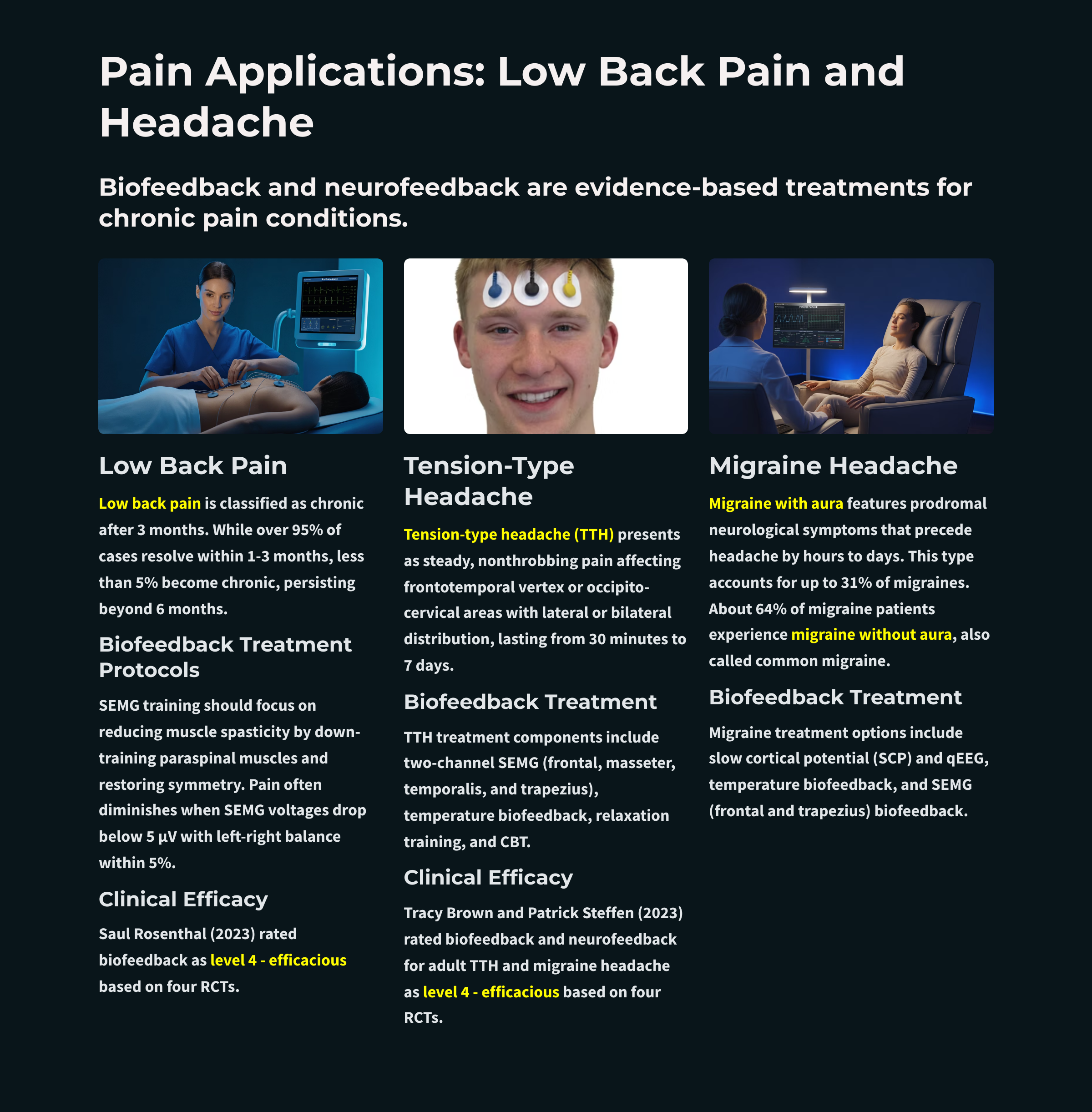
Glossary
α2C-adrenergic receptors (α2C-AR): These are a subtype of alpha-2 adrenergic receptors, which are part of the G protein-coupled receptor (GPCR) family. They play a key role in regulating neurotransmitter release and vascular function. In the central nervous system, a2C-ARs modulate neurotransmission, particularly during low levels of norepinephrine activity, and are involved in processes like mood and cognition. Peripherally, they are expressed on vascular smooth muscle cells in small blood vessels and contribute to cold-induced vasoconstriction by increasing the sensitivity of these vessels to norepinephrine. This makes them particularly important in conditions like Raynaud’s phenomenon, where excessive vasoconstriction occurs in response to cold exposure.
active SEMG training: Neblett’s approach that combines neuromuscular rehabilitation with general relaxation. This strategy involves a collaborative process in which the clinician and client share SEMG biofeedback and the client's self-reports to identify patterns of muscle bracing associated with pain and restricted range of motion and evaluate strategies to correct these problems.
allodynia: the perception of benign stimuli as painful.
asymmetry: an imbalance between the SEMG measurements of homologous left and right muscle groups. A difference of at least a 20% difference is considered pathological and may contribute to pain.
aura (prodrome): neurological symptoms that precede a breakthrough headache, hours to days before headache onset observed in migraine with aura (classic migraine). An aura is caused by cortical spreading depression (hyperpolarization).
basilar artery migraine: headache with prodromal symptoms lasting from 2-45 minutes with symptoms of total blindness, altered consciousness, vertigo, and ataxia (involving the brainstem). Clients experience severe pulsating occipital headaches with vomiting that persists for hours or until sleep.
calcitonin gene-related peptide (CGRP): a neuropeptide, that along with substance P, stimulates pain receptors and increases blood vessel dilation in migraine headaches.
Carpal Tunnel Syndrome (CTS): painful and disabling example of repetitive stress injury (RSI) due to peripheral nerve injury involving inflammation of the tendons that travel through the wrist’s carpal tunnel. These clients experience tingling, numbness, pain in the lower thumb and the first three fingers, muscle weakness in the thenar eminence of the hand, and reduced skin electrical activity and skin temperature.
central sensitization: increased responsiveness of nociceptive neurons in the central nervous system to normal or subthreshold afferent input.
cervical paraspinal placement: active electrodes are placed around C2 and C5 lateral or medial to the spine over the cervical paraspinal muscles.
chronic tension-type headache: steady, nonthrobbing pain that may involve the frontotemporal vertex or occipito-cervical areas with a lateral or bilateral distribution with an average headache frequency of more than 15 days per month for more than 6 months.
classic Raynaud’s: triphasic disorder during which a patient exhibits a color change (pallor, cyanosis, and rubor) in the digits of the hands or feet. All three color changes are observed in only a minority of patients.
cluster headache: episodes that start abruptly without prodromes, 2 to 3 hours after falling asleep, and feature intense, throbbing, unilateral pain involving the eye, temple, neck, and face for 15 to 90 minutes. A typical pattern is one headache every 24 hours for 6-12 weeks (the headaches cluster in time) followed by 12 months of remission. Biofeedback is not efficacious for this type of headache.
cold pressor test: immersion of the hand in ice water container for 1 minute to measure the effect on blood pressure and heart rate. This procedire does not increase sympathetic activity in the digital nerves of Raynaud’s patients, which challenges Raynaud’s sympathetic overactivity hypothesis of this disorder.
Complex Regional Pain Syndromes (CRPS): a chronic progressive disease that involves severe (often burning) pain, swelling, and skin lesions. The International Association for the Study of Pain divides CRPS into Type I, including Reflex Sympathetic Dystrophy (RSD) when nerve damage is absent, and Type II, causalgia, when nerve damage is present. This disorder may progress to dystrophy (weakness or wasting) of the area.
computer-related disorder (CRD): Peper and Gibney’s term for pain experienced when working with a computer. Repetitive motion interacts with many other factors to produce injury and pain.
cortical spreading depression (CSD): a wave of hyperpolarization that moves across the cortex at approximately 3.6 mm/minute. CSD may be responsible for auras in migraine with aura instead of a hypothesized vasoconstrictive process.
cyanosis: in Raynaud’s, a blue skin color is caused by pooled deoxygenated blood due to minimal arteriole inflow and constricted venous outflow.
dual defect model of Raynaud's phenomenon: the explanation that vasospastic episodes arise from the combined effects of sympathetic overactivation and local vascular abnormalities. Heightened sympathetic responses to cold or stress increase norepinephrine release, while hypersensitive a2-adrenergic receptors and endothelial dysfunction in the blood vessels amplify the vasoconstrictive effects. This model unifies systemic triggers and localized vascular defects to explain the condition's pathophysiology.
dura mater: the outermost layer of the three meninges that protect the brain and spinal cord. Trigeminal nerve endings in this layer release proteins that dilate blood vessels and increase the nerves' sensitivity.
erector spinae (sacrospinalis): a muscle that maintains erect position of the spine and extends the vertebral column.
fascia: fibrous connective tissue that divides muscles into functional groups.
fibromyalgia: chronic benign pain disorder that involves pain, tenderness, and stiffness in the connective tissue of muscles, tendons, ligaments, and adjacent soft tissue. The American College of Rheumatology (ACR) adult criteria include widespread pain for at least 3 months on both sides of the body and pain during gentle palpation on 11 of 18 tender points on the neck, shoulder, chest, back, arm, hip, and knee sites.
FpN placement: an active electrode is placed over a frontalis muscle and another over a cervical paraspinal muscle on the same side below the hairline.
frontalis or bifrontal placement: an active electrode is centered above each pupil, midway between the eyebrow and hairline.
Gevirtz's mediational model of muscle pain: lack of assertiveness and resultant worry each trigger sympathetic activation. Increased sympathetic efferent signals to muscle spindles and overexertion can produce a spasm in the muscle spindle's intrafusal fibers, increasing muscle spindle capsule pressure and causing myofascial pain.
healthy computing: a systems approach to treating computer-related disorder (CRD) that includes work style, ergonomics, somatic awareness, stress management, regeneration, vision care, and fitness.
hyperalgesia: mildly painful stimuli are perceived as severely painful.
hypothalamus: A region of the brain responsible for regulating autonomic and endocrine functions, including circadian rhythms, appetite, and pain perception.
insertion: the more movable bone at a joint.
large movement break: leaving the computer and moving around every 20 minutes.
Lewis' local fault hypothesis: explanation that resistance vessels that precede the capillaries overreact to local cooling. This hypothesis is better supported than Raynaud’s sympathetic overactivity hypothesis.
longissimus capitis: a muscle that helps extend and rotate the head to the same side as the contracting muscle and that is retrained following cervical injury.
masseter: muscle that elevates and protracts the mandible. The masseter is down-trained in temporomandibular disorders (TMD).
median nerve: nerve within the carpal tunnel that is compressed in Carpal Tunnel Syndrome (CTS).
medication-overuse headhache: chronic headache, occurring on =15 days/month, caused by the regular overuse (for >3 months) of acute headache medications, often resolving after discontinuation of the offending medication. It typically develops in those with pre-existing primary headache disorders.
micro-break: 1 to 2-second interruption of muscle activation (like the release of forearm muscle activity when a typist reaches the end of a paragraph) about every minute.
migraine equivalent: prodromes without headaches.
migraine generator: a hypothesized circuit in the dorsal raphe nucleus in the upper brainstem activates the trigeminal nerve, whose extensive branches cover the brain "like a helmet" and initiate the migraine.
migraine with aura (classic migraine): a vascular headache that features a prodrome or neurological symptoms that precede a breakthrough headache, hours to days before headache onset. Migraine with arua accounts for up to 31% of all migraine patients.
migraine without aura (common migraine): a vascular headache that is not preceded by a prodrome that accounts for about 64% of all migraine patients and lasts 4-72 hours.
migrainous infarction (complicated migraine): a vascular headache with neurologic symptoms that often follow a definite sequence. This headache involves less than 1-2% of migraineurs and includes hemiplegic, ophthalmoplegic, and basilar migraines.
muscle co-contraction: SEMG levels in one muscle increase from baseline during the contraction of another muscle, for example, when head rotation increases vastus medialis SEMG activity.
muscle spindles: stretch receptors that lie in parallel with skeletal muscle fibers and trigger the monosynaptic stretch reflex.
myelogram: x-ray of nerves using an injected contrast medium to assess nerve damage.
myofascial: Relating to the fascia surrounding and separating muscle tissue.
Myofascial Pain Syndrome (MPS): regional pain disorder characterized by trigger points, which are hyperirritable regions of taut bands of skeletal muscle in the muscle belly or associated fascia (connective tissue).
nifedipine (generic): a drug that inhibits calcium ion influx into vascular smooth muscle. Nifedipine is used to control Raynaud’s disease pharmacologically.
nociceptive: related to the perception of pain.
ophthalmoplegic migraine: a vascular headache with nonpulsating, moderate pain (often with vomiting), and paralysis of one or more extraocular muscles that move the eyes. This disrupts coordinated eye movement and results in double vision.
pallor: in Raynaud’s, white skin color is produced by constriction of arterioles and venules.
palpation: examination by feeling or pressing with the hand.
paraspinal muscle placement: the erector spinae maintains the erect position of the spine and extends the vertebral column. Active pairs are located lateral to the spine, above the iliac crest (rounded upper margins of the ilium bone above the buttocks) about L4 and below the bottom of the ribs at about L2.
passive infrared hemoencephalography (HEG): detection of infrared light that theoretically corresponds to heat generated by local brain metabolism and blood oxygenation.
periaqueductal gray (PAG): midbrain region whose axons form excitatory synapses on neurons located in the nucleus raphe magnus (NRM) and the nucleus reticularis paragigantocellularis (NRPG) in the medulla. The PAG plays a role in the descending modulation of pain and control of defensive behavior. Its ability to suppress pain may be compromised by successive migraines.
pericranial: surrounding or enclosing the skull.
prazosin (Minipress): antagonist at α1-adrenergic receptors that is used to control Raynaud’s disease pharmacologically.
primary RP: The most common form of Raynaud’s, occurring without any underlying medical condition. It is usually less severe and often affects younger individuals, particularly women under 30. Its exact cause is unknown, and it is considered idiopathic (of unknown origin).
protective guarding: SEMG elevation on the side opposite an injury.
Raynaud’s phenomenon: a condition characterized by episodic narrowing (vasospasm) of blood vessels, typically in the fingers and toes, triggered by cold or stress. This leads to reduced blood flow, causing the affected areas to turn white or blue, become cold and numb, and sometimes painful. The condition can be primary (without an underlying cause) or secondary (associated with another disease)
reactive hyperemia: excessive inflow of oxygenated blood into the upper epidermis during the rubor stage of Raynaud’s.
referred pain: pain perceived at a distance from the injury site, for example, angina pectoris.
repetitive stress injury (RSI): syndrome that includes diffuse pain in the arm that worsens with activity and features weakness and lack of endurance. These symptoms do not follow nerve and tendon distributions.
rubor: in Raynaud’s, red skin color and burning sensations result from excessive inflow of oxygenated blood into the upper epidermis.
scapular winging: protrusion of the shoulder blade following a shoulder injury.
secondary RP: A more severe form of Raynaud’s linked to underlying diseases, such as autoimmune disorders (e.g., lupus or scleroderma), vascular diseases, or certain medications. Secondary RP typically develops later in life and may lead to complications like ulcers or tissue damage due to prolonged lack of blood flow.
semispinalis capitis: a muscle that helps extend the head and rotates the head to the side opposite the contracting muscle.
Sherman’s five percent rule: severe acute pain can develop and progress to chronic pain when limbs deviate five degrees from a healthy position, muscles are five percent tenser than required, and muscles remain minimally tense five percent longer than needed.
splenius capitis: a muscle that helps extend the head and rotate the head to the same side as the contracting muscle.
splinting: SEMG elevation on the injured side of the body.
sternocleidomastoid (SCM): a muscle that flexes the vertebral column and rotates the head to the opposite side (contract left SCM and head twists to the right).
substance P: peptide pain transmitter.
supraspinal: Above or superior to the spinal cord, typically referring to brain structures. The key supraspinal structures implicated in TTH central sensitization are the periaqueductal grey, rostral ventromedial medulla, thalamus, somatosensory cortex, anterior cingulate cortex, and insula.
sympathectomy: sympathetic nerve lesion that may be performed in severe cases of Raynaud’s. Symptom improvement is limited to 1-2 years.
sympathetic overactivity hypothesis: explanation that Raynaud’s symptoms are due to increased sympathetic activity in digital nerves. This position is not supported by experimental evidence.
temperature biofeedback under cold challenge: a procedure in which temperature biofeedback teaches the client to maintain peripheral temperature while the affected limb is cooled. This is the most effective biofeedback protocol for treating Raynaud’s.
temporalis: a muscle that elevates and retracts the mandible (jaw).
temporomandibular disorders (TMD): a heterogeneous group of diseases that are characterized by dull pain around the ear, tenderness of jaw muscles, a clicking or popping noise when opening or closing the mouth, limited or abnormal opening of the mouth, headache, tooth sensitivity, and abnormal wearing of the teeth. Pain is triggered by parafunctional jaw clenching and is reported along with headache, other facial pain, neck pain, and pain in the shoulder and back.
tender points: sites of local tenderness located at a muscle's insertion that are distinct from trigger points. Compression produces local pain, but not the referred pain associated with trigger points, and may increase overall pain sensitivity.
tension-type headache: a steady, nonthrobbing pain that may involve the frontotemporal vertex or occipito-cervical areas with a lateral or bilateral distribution.
trapezius: the most superficial back muscle is a triangular muscle sheet covering the posterior neck and superior trunk. The upper trapezius elevates the scapula and helps extend the head, and maybe retrained in tension-type headache.
trigeminal autonomic cephalgias (TACs): A group of primary headache disorders, including cluster headaches, characterized by severe unilateral pain and associated autonomic symptoms.
trigeminal nerve: 5th cranial nerve that receives sensory information about the region from the jaw to the scalp and controls eight muscles. The trigeminal nerve may be activated in all primary headaches by cortical hyperexcitability, producing a breakthrough headache.
trigeminovascular system: a neural pathway involving the trigeminal nerve and associated blood vessels, playing a key role in the transmission of headache pain.
trigger points: hyperirritable regions of taut bands of skeletal muscle in the muscle belly or associated fascia characterize Myofascial Pain Syndrome (MPS). Pressure on these areas is painful, and they can produce referred pain and tenderness, motor dysfunction, and autonomic changes.
triphasic disorder: classic Raynaud’s patients experience skin color changes of pallor, cyanosis, and rubor.
vasoconstriction: narrowing of blood vessels due to the contraction of the smooth muscle in their walls. Increased firing of sympathetic efferent fibers and circulating alpha-adrenergic hormones constrict blood vessels.
vasodilation: widening of blood vessels due to the relaxation of the smooth muscle in their walls, riggered by a beta-adrenergic cascade that culminates in nitric oxide release.
Test Yourself
Click on the ClassMarker logo to take 10-question tests over this unit without an exam password.

REVIEW FLASHCARDS ON QUIZLET
Click on the Quizlet logo to review our chapter flashcards.

Visit the BioSource Software Website
BioSource Software offers Human Physiology, which satisfies BCIA's Human Anatomy and Physiology requirement, and Biofeedback100, which provides extensive multiple-choice testing over BCIA's Biofeedback Blueprint.

Assignment
Now that you have completed this unit, think about how you would explain the medical causes of migraine and tension-type headache to your clients and how biofeedback training produces improvement. Why do practitioners sometimes confuse fibromyalgia with Myofascial Pain Syndrome (MPS). How are they different?
References
Al-Haggar, M. S., Al-Naggar, Z. A., & Abdel-Salam, M. A. (2006). Biofeedback and cognitive behavioral therapy for Egyptian adolescents suffering from chronic fatigue syndrome. Journal of Pediatric Neurology, 4(3), 161-169. https://doi.org/10.1055/s-0035-1557320
Alvarez, D. J., & Rockwell, P. G. (2002). Trigger points: Diagnosis and management. American Family Physician, 65(4), 653-660.
Andrasik, F. (2007). What does the evidence show? Efficacy of behavioral treatments for recurrent headaches in adults. Neurological Sciences, 28, Suppl 2, S70-77. https://doi.org/10.1007/s10072-007-0754-8
Apkarian, A. V., Sosaa, Y., Kraussb, B. R., Thomasc, P. S., Fredricksond, B. E., Levye, R. E., Hardenf, R. N., & Chialvo, D. R. (2004). Chronic pain patients are impaired on an emotional decision-making task. Pain, 108, 129–136. https://doi.org/10.1016/j.pain.2003.12.015
Arena, J. G., Bruno, G. M., Hannah, S. L., & Meader, K. J. (1995). Comparison of frontal electromyographic biofeedback training, trapezius electromyographic biofeedback training, and progressive muscle relaxation therapy in the treatment of tension headache. Headache, 35(7), 411-419. https://doi.org/10.1111/j.1526-4610.1995.hed3507411.x
Ashina, M. (2004). Neurobiology of chronic tension-type headache. Cephalalgia, 24, 161 - 172. https://doi.org/10.1111/j.1468-2982.2003.00644.x.
Ashina, S., Bendtsen, L., & Ashina, M. (2005). Pathophysiology of tension-type headache. Current Pain and Headache Reports, 9(6), 415–422. https://doi.org/10.1007/s11916-005-0021-8
Ashina, M., Stallknecht, B., Bendtsen, L., Pedersen, J. F., Galbo, H., Dalgaard, P., & Olesen, J. (2009). In vivo evidence of altered skeletal muscle blood flow in chronic tension-type headache. Brain, 125, 320-326. https://doi.org/10.1093/brain/awf029
Ashworth, N. L. (2014). Carpal tunnel syndrome. eMedicine.
Babu, A. S., Mathew, E., Danda, D., & Prakash, H. (2007). Management of patients with fibromyalgia using biofeedback: A randomized control trial. Indian Journal of Medical Sciences, 61(8), 455-461. PMID: 17679735
Barowsky, E. I., Zweig, J. B., & Moskowitz, J. (1987). Thermal biofeedback in the treatment of symptoms associated with reflex sympathetic dystrophy. Journal of Child Neurology, 2(3), 229-232. https://doi.org/10.1177/088307388700200311
Baskin, S. M. (2014). Presentation at the 45th annual scientific meeting of the Association for Applied Psychophysiology and Biofeedback (AAPB), Savannah, Georgia.
Baskin, S. M., & Weeks, R. E. (2003). The biobehavioral treatment of headache. In D. Moss, A. McGrady, T. Davies, and I. Wickramasekera (Eds.), Handbook of mind-body medicine for primary care. Sage Publications, Inc.
Basmajian, J. V. (Ed.). (1989). Biofeedback: Principles and practice for clinicians. Williams & Wilkins.
Benore, E. (2023). Pediatric headache. In I. Khazan, F. Shaffer, D. Moss, R. Lyle, & S. Rosenthal (Eds). Evidence-based practice in biofeedback and neurofeedback (4th ed.). Association for Applied Psychophysiology and Biofeedback.
Bhoi, S. K., Jha, M., & Chowdhury, D. (2021). Advances in the understanding of pathophysiology of TTH and its management. Neurology India, 69(Supplement), S116–S123. https://doi.org/10.4103/0028-3886.315986
Blanchard, E. B. (1979). The use of temperature biofeedback in the treatment of chronic pain due to causalgia. Biofeedback and Self- Regulation, 4(2), 183-188. https://doi.org/10.1007/BF01007112
Blanchard, E. B., Andrasik, F., Evans, D. D., Neff, D. F., & Appelbaum, K. A. (1985). Behavioral treatment of 250 chronic headache patients: A clinical replication series. Behavior Therapy, 16, 308- 327. https://doi.org/10.1016/S0005-7894(85)80019-8
Blanchard, E. B., Peters, M. L., Hermann, C., Turner, S. M., Buckley, T. C., Barton, K., Dentinger, M. P. (1997). Direction of temperature control in the thermal biofeedback treatment of vascular headache. Applied Psychophysiology and Biofeedback, 22(4), 227- 245. https://doi.org/10.1007/bf02438978
Blanchard, E. B., & Diamond, S. (1996). Psychological treatment of benign headache disorders. Professional Psychology: Research and Practice, 27(5), 541-547. https://doi.org/10.1037//0022-006x.60.4.537
Blanchard, E. B., Jaccard, J., Andrasik, F., Guarnieri, P., & Jurish, S. E. (1985). Reduction in headache patients' medical expenses associated with biofeedback and relaxation treatments. Biofeedback and Self-Regulation, 10(1), 63-68. https://psycnet.apa.org/doi/10.1007/BF00998678
Blanda, M. (2015). Cluster headache. eMedicine.
Blanda, M. (2015). Tension headache. eMedicine.
Burstein, R., Noseda, R., & Borsook, D. (2019). Migraine: Multiple processes, complex pathophysiology. Journal of Neuroscience, 39(42), 8537–8546. https://doi.org/10.1523/JNEUROSCI.0519-19.2019
Carlson, J. G., Seifert, A. R., & Birbaumer, N. (Eds.). (1994). Clinical applied psychophysiology. Plenum Press.
Caro, X. J., & Winter, E. F. (2011). EEG biofeedback treatment improves certain attention and somatic symptoms in fibromyalgia: A pilot study. Applied Psychophysiology and Biofeedback, 36(3), 193-200. https://doi.org/10.1007/s10484-011-9159-9
Chauhan, T. S. (2003). RSI placing a strain on workplace. Canadian Medical Association Journal, 169(11), 1203.
Chawla, J. (2014). Migraine headache. eMedicine.
Chen, Y. (2009). Advances in the pathophysiology of tension-type headache: From stress to central sensitization. Current Pain and Headache Reports, 13(6), 484-494. https://doi.org/10.1007/s11916-009-0078-x
Cott, A., Parkinson, W., Fabich, M., Bedard, M., & Marlin, E. R. (1992). Long-term efficacy of combined relaxation: Biofeedback treatments for chronic headache. Pain, 51, 49-56. https://doi.org/10.1016/0304-3959(92)90008-y
Cram, J. R. (1988). Personal communication.
Cram, J. R. (2011). E. Criswell (Ed.). Cram's introduction to surface electromyography (2nd ed.). Jones and Bartlett Publishers.
Cram, J. R., & associates (1990). Clinical EMG for surface recordings: Volume 2. Clinical Resources.
Crider, A., Glaros, A. G., & Gevirtz, R. N. (2005). Efficacy of biofeedback-based treatments for temporomandibular disorders. Applied Psychophysiology and Biofeedback, 30(4), 333-345. https://doi.org/10.1007/s10484-005-8420-5
Crockett, D. J., Foreman, M. E., Alden, L., & Blasberg, B. (1986). A comparison of treatment modes in the management of myofascial pain dysfunction syndrome. Biofeedback and Self-Regulation, 11, 279-291. https://doi.org/10.1007/bf01000164
D'Andrea, G., Cevoli, S., Colavito, D., & Leon, A. (2015). Biochemistry of primary headaches: Role of tyrosine and tryptophan metabolism. Neurological Sciences, 36, 17-22. https://doi.org/10.1007/s10072-015-2131-3.
Dahlstrom, L., & Carlsson, S. G. (1984). Treatment of mandibular dysfunction: The clinical usefulness of biofeedback in relation to splint therapy. Journal of Oral Rehabilitation, 11, 277-284. https://doi.org/10.1111/j.1365-2842.1984.tb00577.x
Dahlstrom, L., Carlsson, S. G., Gale, E. N., & Jansson, T. G. (1984). Clinical and electromyographic effects of biofeedback training in mandibular dysfunction. Biofeedback and Self-Regulation, 9, 37-47. https://doi.org/10.1007/bf00998844
Dalen, K., Ellertsen, B., Espelid, I., & Gronningsaetr, A. (1986). EMG biofeedback in the treatment of myofascial pain dysfunction syndrome. Acta Odontology Scandinavia, 44, 279-284. https://doi.org/10.3109/00016358609004734
Desmeules, J. A., Cedraschi, C., Rapiti, E., Baumgartner, E., Finckh, A., Cohen, P., Dayer, P., & Vischer, T. L. (2003). Neurophysiologic evidence for a central sensitization in patients with fibromyalgia. Arthritis & Rheumatism, 48(5), 1420-1429. https://doi.org/10.1002/art.10893
Dietz, V. (2002). Proprioception and locomotor disorders. Nature Reviews Neuroscience, 3(10), 781–790. https://doi.org/10.1038/nrn939
Dohrmann, R. J., & Laskin, D. M. (1978). An evaluation of electromyographic biofeedback in the treatment of myofascial pain-dysfunction syndrome. Journal of the American Dental Association, 96, 656-662. https://doi.org/10.14219/jada.archive.1978.0128
Donaldson, C. C. S. (1989). The effect of correcting muscle asymmetry upon chronic low back pain. Unpublished doctoral dissertation. University of Calgary.
Donaldson, S., & Donaldson M. (1990). Multi-channel EMG assessment and treatment techniques. In J. R. Cram (Ed.). Clinical EMG for surface recordings: Volume 2. Clinical Resources.
Donaldson, C. C. S., & Sella, G. E. (2003). Fibromyalgia. In D. Moss, A. McGrady, T. C. Davies, & I. Wickramasekera (Eds.), Handbook of mind-body medicine for primary care. Sage Publications Inc.
Donaldson, C. C. S., Snelling, L. S., MacInnis, A. L., Sella, G. E., & Mueller, H. H. (2002). Diffuse muscular coactivation (DMC) as a potential source of pain in fibromyalgia -- Part 1. NeuroRehabilitation, 17(1): 33-39. PMID: 12016345
Dworkin, R. H., Turk, D. C., Farrar, J. T., Haythornthwaite, J. A., Jensen, M. P., Katz, N. P., Kerns, R. D., Stucki, G., Allen, R. R., Bellamy, N., Carr, D. B., Chandler, J., Cowan, P., Dionne, R., Galer, Hertz, S., Jadad, A. R., Kramer, L. D., Manning, D. C., . . . Witter, J. (2005). Core outcome measures for chronic pain clinical trials: IMMPACT recommendations. Pain, 113, 9-19. https://doi.org/10.1016/j.pain.2004.09.012
Dworkin, S. F., & LeResche, L. (Eds.). (1992). Research diagnostic criteria for temporomandibular disorders: Review, criteria, examinations and specifications, critique. Journal of Craniomandibular Disorders: Facial and Oral Pain, 6, 301-355. PMID: 1298767
Finley, J. E. (2013). Physical medicine and rehabilitation for myofascial pain. eMedicine.
Flor, H., & Diers, M. (2007). Limitations of pharmacotherapy: Behavioral approaches to chronic pain. Handb Exp Pharmacol, (177), 415-427. https://doi.org/10.1007/978-3-540-33823-9_15
Freedman, R. R., & Ianni, P. (1983). Role of cold and emotional stress in Raynaud’s disease and scleroderma. British Medical Journal, 287, 1499–1502. https://dx.doi.org/10.1136%2Fbmj.287.6404.1499
Freedman, R. R., Ianni, P., & Wenig, P. (1985). Behavioral treatment of Raynaud’s disease: Long-term follow-up. Journal of Consulting and Clinical Psychology, 53, 136. https://doi.org/10.1037//0022-006x.53.1.136
Freedman, R. R., Moten, M., Migaly, P., & Mayes, M. (1993). Cold-induced potentiation of a2-adrenergic vasoconstriction in idiopathic Raynaud’s disease. Arthritis and Rheumatism, 36, 685–690. https://doi.org/10.1002/art.1780360517
Freedman, R. R., Sabharwal, S. G., Ianni, P., Desai, N., Wenig, P., & Mayes, M. (1988). Nonneural beta-adrenergic vasodilating mechanism in temperature biofeedback. Psychosomatic Medicine, 50, 394–401. https://doi.org/10.1097/00006842-198807000-00007
Furspan, P. B., Snapir, M., & Hughes, M. (2024). Enhanced contractile response to a2-adrenergic agonists in Raynaud phenomenon. Journal of Vascular Research, 61(4), 123–135. https://doi.org/10.1159/000515789
Gardea, M. A., Gatchel, R. J., & Mishra, K. D. (2001). Long-term efficacy of biobehavioral treatment of temporomandibular disorders. Journal of Behavioral Medicine, 24(4), 341-359. https://psycnet.apa.org/doi/10.1023/A:1010682818427
Gatchel, R. J., Stowell, A. W., Wildenstein, L., Riggs, R., & Ellis, E., 3rd. (2006). Efficacy of an early intervention for patients with acute temporomandibular disorder-related pain: A one-year outcome study. Journal of the American Dental Association, (1939), 137(3), 339-347. https://doi.org/10.14219/jada.archive.2006.0183
Gerr, F., Marcus, M., Ensor, C., Kleinbaum, D., Cohen, S., Edwards, A., Gentry, E., Ortiz, D. J., & Monteilh, C. (2002). A prospective study of computer users: 1. Study design and incidence of musculoskeletal symptoms and disorders. American Journal of Industrial Medicine, 41, 221-235. https://doi.org/10.1002/ajim.10066
Gerwin, R. D., Dommerholt, J., & Shah, J. P. (1997). An expansion of Simons’ integrated hypothesis of trigger point formation. Current Pain and Headache Reports, 8(6), 468–475. https://doi.org/10.1007/s11916-004-0009-4
Gevirtz, R. (2003). The mind/muscle connection: A search for psychophysiological mechanisms of chronic muscle pain. Special Address presented at the 34th AAPB annual convention at Jacksonville, Florida.
Giffin, N. J., Ruggiero, L., Lipton, R. B., Silberstein, S. D., & Tvedskov, J. F. (2003). Premonitory symptoms in migraine: An electronic diary study. Neurology, 60(6), 935–940. https://doi.org/10.1212/01.WNL.0000052998.58526.A9
Gilbert, C. (2023). Fibromyalgia. In I. Khazan, F. Shaffer, D. Moss, R. Lyle, & S. Rosenthal (Eds). Evidence-based practice in biofeedback and neurofeedback (4th ed.). Association for Applied Psychophysiology and Biofeedback.
Glaros, A. G. (2007). Patients with acute painful TMD at high risk for developing a chronic condition report less pain, emotional distress, and health care use after a psychological intervention using cognitive-behavioral skills training and biofeedback. J Evid Based Dent Pract, 7(1), 14-16. https://doi.org/10.1016/j.jebdp.2006.12.007
Glaros, A. G., & Burton, E. (2004). Parafunctional clenching, pain, and effort in temporomandibular disorder. Journal of Behavioral Medicine, 27(1), 91-100. https://doi.org/10.1023/B:JOBM.0000013646.04624.8f
Glaros, A. G., & Ohrbach, R. (2023). Temporomandibular disorders. In I. Khazan, F. Shaffer, D. Moss, R. Lyle, & S. Rosenthal (Eds). Evidence-based practice in biofeedback and neurofeedback (4th ed.). Association for Applied Psychophysiology and Biofeedback.
Glombiewski, J. A., Bernardy, K., & Hauser, W. (2013). Efficacy of EMG and EEG biofeedback in Fibromyalgia Syndrome: A meta-analysis and a systematic review of randomized controlled trials. Evid Based Complement Alternat Med, 2013, 962741. https://doi.org/10.1155/2013/962741
Goadsby, P. J., Lipton, R. B., & Ferrari, M. D. (2002). Migraine--Current understanding and treatment. The New England Journal of Medicine, 346(4), 257-270. https://doi.org/10.1056/nejmra010917
Goslin, R. E., Gray, R. N., McCrory, D. C., Penzien, D., Rains, J., & Hasselblad, V. (1999, February). Behavioral and physical treatments for migraine headache. Technical review 2.2. (Prepared for the Agency for Health Care Policy and Research under Contract # 290-94-2025). Available from the National Technical Information Service; NTIS Accession No. 127946.
Graafsma, S. J., Wollersheim, H., Droste, H. T., ten Dam, M. A. G. J., van Tits, L. J. H., Reyenga, J., de Miranda, J. F. R., & Thien, T. (1991). Adrenoreceptors on blood cells from patients with primary Raynaud’s phenomenon. Clinical Science, 80, 325–331. https://doi.org/10.1042/cs0800325
Grunert, B. K., Devine, C. A., Sanger, J. R., Matloub, H. S., & Green, D. Thermal self-regulation for pain control in reflex sympathetic dystrophy syndrome. The Journal of Hand Surgery, 15(4), 615-618. https://doi.org/10.1016/s0363-5023(09)90024-7
Guardia III, C. F. (2014). Temporomandibular disorders. eMedicine.
Guglielmi, R. S., Roberts, A. H., & Patterson, R. (1982). Skin temperature biofeedback for Raynaud's disease: A double-blind study. Biofeedback & Self-Regulation, 7(1), 99-120. https://doi.org/10.1007/bf00999058
Hadhazy, V. A., Ezzo, J., Creamer, P., & Berman, B. M. (2000). Mind-body therapies for the treatment of fibromyalgia. A systematic review. Journal of Rheumatology, 27(12), 2911-2918. PMID: 11128685
Hallett, J. W., Jr. (2014). Raynaud syndrome. The Merk manual.
Hallman, D. M., Olsson, E. M., von Scheele, B., Melin, L., & Lyskov, E. (2011). Effects of heart rate variability biofeedback in subjects with stress-related chronic neck pain: A pilot study. Applied Psychophysiology and Biofeedback, 36(2), 71-80. https://doi.org/10.1007/s10484-011-9147-0
Hartje, J. (1997). Biofeedback: Basic neuromuscular intervention (module 3). Association for Applied Psychophysiology and Biofeedback.
Hartje, J. (1997). Biofeedback: Specific neuromuscular intervention (module 4). Association for Applied Psychophysiology and Biofeedback.
Hassett, A. L., Radvanski, D. C., Vaschillo, E. G., Vaschillo, B., Sigal, L. H., Karavidas, M. K., . . . Lehrer, P. M. (2007). A pilot study of the efficacy of heart rate variability (HRV) biofeedback in patients with fibromyalgia. Applied Psychophysiology and Biofeedback, 32(1), 1-10. https://doi.org/10.1007/s10484-006-9028-0
Hatch, J. P., Moore, P. J., Borcherding, S., Cyr-Provost, M., Boutros, N. N., & Seleshi, E. (1992). Electromyographic and affective responses of episodic tension-type headache patients and headache-free controls during stressful task performance. Journal of Behavioral Medicine, 15(1), 89-112. https://doi.org/10.1007/bf00848379
Herrick, A. L. (2012). Pathogenesis of Raynaud's phenomenon. Rheumatology, 51(10), 174–181. https://doi.org/10.1093/rheumatology/ker398
Holroyd, K. A., & Penzien, D. B. (1990). Pharmacological versus nonpharmacological prophylaxis of recurrent migraine headache: A meta-analytic review of clinical trials. Pain, 42, 1-13. https://doi.org/10.1016/0304-3959(90)91085-w
Hunter, O. K. (2014). Cervical sprain and strain. eMedicine.
Jensen, M. P., Hakimian, S., Sherlin, L. H., & Fregni, F. (2008). New insights into neuromodulatory approaches for the treatment of pain. J Pain, 9(3), 193-199. https://doi.org/10.1016/j.jpain.2007.11.003
Kahaleh, B., & Matucci-Cerinic, M. (2020). Raynaud’s phenomenon: Pathophysiology and management. Clinical Reviews in Allergy & Immunology, 58(3), 1–10. https://doi.org/10.1007/s12016-019-08754-7
Kanji, N., White, A. R., & Ernst, E. (2006). Autogenic training for tension type headaches: A systematic review of controlled trials. Complement Ther Med, 14(2), 144-150. https://doi.org/10.1016/j.ctim.2006.03.001
Karavidas, M. K., Tsai, P., Yucha, C., McGrady, A., & Lehrer, P. M. (2006) Thermal biofeedback for primary Raynaud’s phenomenon: A review of the literature. Applied Psychophysiology and Biofeedback, 31(3), 203-216. https://doi.org/10.1007/s10484-006-9018-2
Kaushik, R., Kaushik, R. M., Mahajan, S. K., & Rajesh, V. (2005). Biofeedback-assisted diaphragmatic breathing and systematic relaxation versus propranolol in long term prophylaxis of migraine. Complementary Therapies in Medicine, 13(3), 165-174. https://doi.org/10.1016/j.ctim.2005.04.004
Kayiran, S., Dursun, E., Ermutlu, N., Dursun, N., & Karamursel, S. (2007). Neurofeedback in fibromyalgia syndrome. Agri, (3), 47-53. PMID: 18095199
Khazan, I. Z. (2013). The clinical handbook of biofeedback: A step-by-step guide for training and practice with mindfulness. John Wiley & Sons, Ltd.
Kropp, P., Siniatchkin, M., & Gerber, W. D. (2002). On the pathophysiology of migraine--Links for "empirically based treatment" with neurofeedback. Applied Psychophysiology and Biofeedback, 27(3), 203-213. https://doi.org/10.1023/a:1016251912324
Lang, E., Kaltenhäuser, M., Neundörfer, B., & Seidler, S. (2004). Hyperexcitability of the primary somatosensory cortex in migraine—A magnetoencephalographic study. Brain, 127(11), 2459-2469. https://doi.org/10.1093/brain/awh295
Launer, L. J., Terwindt, G. M., & Ferrari, M. D. (1999). The prevalence and characteristics of migraine in a population-based cohort: The GEM study. Neurology, 53, 537-542. https://doi.org/10.1212/WNL.53.3.537
Linton, S., & Kamwendo, K. (1989). Risk factors in the psychological work environment for neck and shoulder pain in secretaries. J Occ Med, 31(7), 609-613. https://doi.org/10.1097/00043764-198907000-00012
Martin, P. R., Forsyth, M. R., & Reece, J. (2007). Cognitive-behavioral therapy versus temporal pulse amplitude biofeedback training for recurrent headache. Behavior Therapy, 38(4), 350-363. https://doi.org/10.1016/j.beth.2006.10.004
Martin, V., & Elkind, A. (2005). Diagnosis and classification of primary headache disorders. Standards of care for headache diagnosis and treatment. National Headache Foundation.
May, A., Bahra, A., Büchel, C., Frackowiak, R. S., & Goadsby, P. J. (1998). Hypothalamic activation in cluster headache attacks. The Lancet, 352(9124), 275–278. https://doi.org/10.1016/S0140-6736(98)02470-2
McCrory, D. C., Penzien, D. B., & Rains, J. C. (1996). Efficacy of behavioral treatments for migraine and tension-type headache: Meta-analysis of controlled trials [Abstract]. Headache, 36, 272.
McGrady, A. V., Andrasik, F., Davies, T., Striefel, S., Wickramasekera, I. Baskin, S. M., Penzien, D. B., & Tietjen, G. (1999). Psychophysiological therapy for chronic headache in primary care. Primary Care Companion, Journal of Clinical Psychiatry, 1(4), 96-102. https://dx.doi.org/10.4088%2Fpcc.v01n0401
McGrady, A., & Moss, D. (2013). Pathways to illness, pathways to health. Springer.
McGrady, A., Wauquier, A., McNeil, A., & Gerard, C. (1994). Effect of biofeedback-assisted relaxation on migraine headache and changes in cerebral blood flow velocity in the middle cerebral artery. Headache, 34(7), 424-428. https://doi.org/10.1111/j.1526-4610.1994.hed3407424.x
Medlicott, M. S., & Harris, S. R. (2006).. Physical Therapy, 86(7), 955-973. A systematic review of the effectiveness of exercise, manual therapy, electrotherapy, relaxation training, and biofeedback in the management of temporomandibular disorder. Phy Ther, 86(7), 955-973. PMID: 16813476
Meehan, Z. M., & Shaffer, F. (2023). Repetitive strain injury (RSI). In I. Khazan, F. Shaffer, D. Moss, R. Lyle, & S. Rosenthal (Eds). Evidence-based practice in biofeedback and neurofeedback (4th ed.). Association for Applied Psychophysiology and Biofeedback.
Middaugh, S. J., et al. (2001). The Raynaud’s Treatment Study: Biofeedback protocols and acquisition of temperature biofeedback skills. Applied Psychophysiology and Biofeedback, 26(4), 251-278. https://doi.org/10.1023/a:1013182519331
Millea, P. J., & Brodie, J. J. (2002). Tension-type headache. American Family Physician, 66(5), 797-805.
Mitani, Y., Fukunaga, M., Kanbara, K., Takebayashi, N., Ishino, S., & Nakai, Y. (2006). Evaluation of psychophysiological asymmetry in patients with fibromyalgia syndrome. Applied Psychophysiology and Biofeedback, 31(3), 217-225. https://doi.org/10.1007/s10484-006-9020-8
Moore, L. E., & Wiesner, S. L. (1996). Hypnotically-induced vasodilation in the treatment of repetitive strain injuries. American Journal of Clinical Hypnosis, 39(2), 97-104. https://doi.org/10.1080/00029157.1996.10403372
Mora, M. C. S., Weber, D., Neff, A., & Rief, W. (2013). Biofeedback-based cognitive-behavioral treatment compared with occlusal splint for temporomandibular disorder: A randomized controlled trial. Clinical Journal of Pain, 29, 1057-1065. https://doi.org/10.1097/ajp.0b013e3182850559
Mueller, H. H., Donaldson, C. C. S., Nelson, D. V., & Layman, M. (2001). Treatment of fibromyalgia incorporating EEG-driven stimulation: A clinical outcomes study. Journal of Clinical Psychology, 57(7), 933-952. https://doi.org/10.1002/jclp.1060
Myers, C. D. (2007). Complementary and alternative medicine for persistent facial pain. Dental Clinics North America, 51(1), 263-274. https://doi.org/10.1016/j.cden.2006.09.008
National Headache Foundation (1999). Standards of care for headache diagnosis and treatment (2nd ed.). National Headache Foundation.
Neblett, R. (2002a). Active sEMG training for chronic musculoskeletal pain -- Part 1. Biofeedback, 30(2), 28-31. https://dx.doi.org/10.3390%2Fhealthcare4020027
Neblett, R. (2002b). Active sEMG training for chronic musculoskeletal pain -- Part 2. Biofeedback, 30(3/4), 39-42.
Neblett, R. (2006). Personal communication regarding active SEMG training.
Nestoriuc, Y., & Martin, A. (2007). Efficacy of biofeedback for migraine: A meta-analysis. Pain, 128(1-2), 111-127. https://doi.org/10.1016/j.pain.2006.09.007
Netsoriuc, Y., Martin, A., Rief, W., & Andrasik, F. (2008). Biofeedback treatment for headache disorders: A comprehensive efficacy review. Applied Psychophysiology and Biofeedback, 33, 125-140. https://doi.org/10.1007/s10484-008-9060-3
Nestoriuc, Y., Rief, W., & Martin, A. (2008). Meta-analysis of biofeedback for tension-type headache: Efficacy, specificity, and treatment moderators. J Consult Clin Psychol, 76(3), 379-396. https://doi.org/10.1037/0022-006x.76.3.379
Newton-John, T. R., Spence, S. H., & Schotte, D. (1995). Cognitive-behavioural therapy versus EMG biofeedback in the treatment of chronic low back pain. Behavioural Research & Therapy, 33(6), 691-697. https://doi.org/10.1016/0005-7967(95)00008-l
NIH Technology Assessment Panel (1996). Integration of behavioral and relaxation approaches into the treatment of chronic pain and insomnia.NIH Technology Assessment Panel on Integration of Behavioral and Relaxation Approaches into the Treatment of Chronic Pain and Insomnia. JAMA, 276, 313-318. https://doi.org/10.1001/jama.1996.03540040057033
Peper, E., & Gibney, K. H. (1999). Computer related symptoms: A major problem for college students. Proceedings of the Thirtieth Annual Meeting of the Association for Applied Psychophysiology and Biofeedback. Association for Applied Psychophysiology and Biofeedback.
Peper, E., & Gibney, K. H. (2005). Physiological rationale for microbreaks. Biofeedback, 33(1), 38-39.
Peper, E., & Gibney, K. H. (2005). Peper "60 Second Protocol." NEXGEN Ergonomics. http://www.nexgenergo.com/ergocenter/trends/trends2.html.
Peper, E., & Gibney, K. H. (2006). Muscle biofeedback at the computer: A manual to prevent repetitive strain injury (RSI) by taking the guesswork out of assessment, monitoring, and training. Biofeedback Federation of Europe.
Peper, E., Gibney, K. H., & Wilson, V. E. (2004). Group training with healthy computing practices to prevent Repetitive Strain Injury (RSI): A preliminary study. Applied Psychophysiology and Biofeedback, 29(4), 279-287. https://doi.org/10.1007/s10484-004-0388-z
Peper, E., Wilson, V. S., Gibney, K. H., Huber, K., Harvey, R., & Shumay, D. (2003). The integration of electromyography (sEMG) at the workstation: Assessment, treatment and prevention of repetitive strain injury (RSI). Applied Psychophysiology and Biofeedback, 28(2), 167-182. https://doi.org/10.1023/a:1023818810766
Radovanovic, D., Peikert, K., Lindström, M., & Domellöf, F. (2015). Sympathetic innervation of human muscle spindles. Journal of Anatomy, 226, 542 - 548. https://doi.org/10.1111/joa.12309
Rains, J. C. (2008). Change mechanisms in EMG biofeedback training: Cognitive changes underlying improvements in tension headache. Headache, 48(5), 735-736, Discussion 736-737. https://doi.org/10.1111/j.1526-4610.2008.01119_1.x
Raynaud's Treatment Study Investigators (2000). Comparison of sustained-release nifedipine and temperature biofeedback for treatment of primary Raynaud's phenomenon. Results from a randomized clinical trial with 1-year follow-up. Archives of Internal Medicine, 160(8), 1101-1108. https://doi.org/10.1001/archinte.160.8.1101
Rosenthal, S. (2023). Chronic pain. In I. Khazan, F. Shaffer, D. Moss, R. Lyle, & S. Rosenthal (Eds). Evidence-based practice in biofeedback and neurofeedback (4th ed.). Association for Applied Psychophysiology and Biofeedback.
Sarnoch, H., Adler, F., & Scholz, O. B. (1997). Relevance of muscular sensitivity, muscular activity, and cognitive variables for pain reduction associated with EMG biofeedback in fibromyalgia. Perceptual and Motor Skills, 84(3 Pt 1), 1043-1050. https://doi.org/10.2466/pms.1997.84.3.1043
M. S. Schwartz, & F. Andrasik (Eds.). (2003). Biofeedback: A practitioner's guide (3rd ed.). The Guilford Press.
Schulte, L. H., & May, A. (2016). The migraine generator revisited: Continuous scanning of the migraine cycle over 30 days and three spontaneous attacks. Brain, 139(7), 1987–1993. https://doi.org/10.1093/brain/aww097
Sedlacek, K., & Taub, E. (1996). Biofeedback treatment of Raynaud’s Disease. Professional Psychology: Research and Practice, 27(6), 548- 553. https://psycnet.apa.org/doi/10.1037/0735-7028.27.6.548
Sella, G. E. (2003). Back pain: Musculoskeletal pain syndrome. In D. Moss, A. McGrady, T. Davies, and I. Wickramasekera (Eds.), Handbook of mind-body medicine for primary care. Sage Publications, Inc.
Shaffer, F., & Meehan, Z. M. (2023). Raynaud's disease. In I. Khazan, F. Shaffer, D. Moss, R. Lyle, & S. Rosenthal (Eds). Evidence-based practice in biofeedback and neurofeedback (4th ed.). Association for Applied Psychophysiology and Biofeedback.
Sherman, R. A. (2004). Pain assessment and intervention. Association for Applied Psychophysiology and Biofeedback.
Shumay, D. M., & Peper, E. (1995). Subjective awareness of muscle tension at the keyboard. Proceedings of the Twenty-Sixth Annual Meeting of the Association for Applied Psychophysiology and Biofeedback. Association for Applied Psychophysiology and Biofeedback.
Silberstein, S. D. (2000). Practice parameter: Evidence-based guidelines for migraine headache (an evidence-based review): Report of the quality standards subcommittee of the American Academy of Neurology. Neurology, 55, 754-762. https://doi.org/10.1212/wnl.55.6.754
Sim, J., & Adams, N. (1999). Physical and other non-pharmacological interventions for fibromyalgia. Bailliere's Best Practice Research Clinical Rheumatology, 13(3), 507-533. https://doi.org/10.1053/berh.1999.0041
Simlan, A., Holligan, S., Brennan, P., & Maddison, P. (1990). Prevalence of symptoms of Raynaud’s phenomenon in general practice. British Medical Journal, 301, 590–592. https://doi.org/10.1136/bmj.301.6752.590
Siniatchkin, M., Hierundar, A., Kropp, P., Kuhnert, R., Gerber, W. D., & Stephani, U. (2000). Self-regulation of slow cortical potentials in children with migraine: An exploratory study. Applied Psychophysiology and Biofeedback, 25(1), 13-32. https://doi.org/10.1023/a:1009581321624
Snapir, M., Hughes, M., & Furspan, P. B. (2024). Multinational qualitative research study exploring the patient experience of Raynaud's phenomenon in systemic sclerosis. Qualitative Health Research, 34(2), 178–190. https://doi.org/10.1177/1049732321107329
Sporbeck, B., Mathiske-Schmidt, K., Jahr, S., Huscher, D., Becker, M., Riemekasten, G., Taufmann, I., Burmester, G. R., Pogel, S, & Reisshauer, A. (2012). Effect of biofeedback and deep oscillation on Raynaud’s phenomenon secondary to systemic sclerosis: Results of a controlled prospective randomized clinical trial. Rheumatology International, 32, 1469-1473. https://doi.org/10.1007/s00296-011-1882-2
Stokes, D. A., & Lappin, M. S. (2010). Neurofeedback and biofeedback with 37 migraineurs: A clinical outcome study. Behavioral and Brain Functions, 6(9), 2-10. https://doi.org/10.1186/1744-9081-6-9
Stowell, A. W., Gatchel, R. J., & Wildenstein, L. (2008). Cost-effectiveness of treatments for temporomandibular disorders: Biopsychosocial intervention versus treatment as usual. Journal of the American Dental Association, 138(2), 202-208. https://doi.org/10.14219/jada.archive.2007.0137
Tortora, G. J., & Derrickson, B. H. (2021). Principles of anatomy and physiology (16th ed.). John Wiley & Sons, Inc.
Trautmann, E., Lackschewitz, H., & Kroner-Herwig, B. (2006). Psychological treatment of recurrent headache in children and adolescents - A meta-analysis. Cephalalgia, 26(12), 1411-1426. https://doi.org/10.1111/j.1468-2982.2006.01226.x
Tries, J., & Brubaker, L. (1996). Application of biofeedback in the treatment of urinary incontinence. Professional Psychology: Research and Practice, 27(6), 554-560. https://psycnet.apa.org/doi/10.1037/0735-7028.27.6.554
Tries, J., Eisman, E., & Lowery, S. P. (1995). Fecal incontinence. In M. S. Schwartz (Ed.). (1995). Biofeedback: A practitioner's guide. The Guilford Press.
Turk, D. C., Dworkin, R. H., Allen, R. R., Bellamy, N., Brandenburg, N., Carr, D. B., Cleeland, C., Dionne, R., Farrar, J. T., Galer, B. S., Hewitt, D. J., Jadad, A. R., Katz, N. P., Kramer, L. D., Manning, D. C., MCormick, C. G., McDermott, M. P., McGrath, P., Quessy, S., ... Witter, J. (2003). Core outcome domains for chronic pain clinical trials: IMMPACT recommendations. Pain, 106, 337-45. https://doi.org/10.1016/j.pain.2003.08.001
Turk, D. C., Rudy, T. E., Kubinski, J. A., Zaki, H. S., & Greco, C. M. (1996). Dysfunctional patients with temporomandibular disorders: Evaluating the efficacy of a tailored treatment protocol. Journal of Consulting and Clinical Psychology, 64, 136-146. https://doi.org/10.1037//0022-006x.64.1.139
Turk, D. C., Zaki, H. S., & Rudy, T. E. (1993). Effects of intraoral appliance and biofeedback/stress management alone and in combination in treating pain and depression in patients with temporomandibular disorders. Journal of Prosthetic Dentistry, 70(2), 158-164. https://doi.org/10.1016/0022-3913(93)90012-d
Turp, J. C., Jokstad, A., Motschall, E., Schindler, H. J., Windecker-Gatz, I., & Ettlin, D. A. (2007). Is there a superiority of multimodal as opposed to simple therapy in patients with temporomandibular disorders? A qualitative systematic review of the literature. Clinical Oral Implications Research, 18(Suppl. 3), 138-150. https://doi.org/10.1111/j.1600-0501.2007.01480.x
Turton, E. P. L., Kent, P. J., & Kester, R. C. (1998). The aetiology of Raynaud’s phenomenon. Cardiovascular Surgery, 6, 431–440. https://doi.org/10.1177%2F096721099800600501
Vagades, J., Gordon, C., Schwaemmle, M., Andrasik, F., Gevirtz, R. N., Hautzinger, M., & Birbaumer, N. (2011). Does deep breathing training improve myofascial release in combination with trigger point therapy for patients with low back pain? Oral presentation at the 15th annual meeting of the Biofeedback Foundation of Europe. Munich, Germany.
Vasudeva, S., Claggett, A. L., Tietjen, G. E., & McGrady, A. V. (2003). Biofeedback-assisted relaxation in migraine headache: Relationship to cerebral blood flow velocity in the middle cerebral artery. Headache, 43(3), 245-250. https://doi.org/10.1046/j.1526-4610.2003.03048.x
Veldman, P. H., Reynen, H. M., & Arntz, I. E. (1993). Signs and symptoms of reflex sympathetic dystrophy: Prospective study of 829 patients. Lancet, 342(8878), 1012-1016. https://doi.org/10.1016/0140-6736(93)92877-v
Verhagen, A. P., Damen, L., Berger, M. Y., Passchier, J., Merlijn, V., & Koes, B. W. (2005). Conservative treatments of children with episodic tension-type headache: A systematic review. Journal of Neurology, 252(10), 1147-1154. https://doi.org/10.1007/s00415-005-0940-7
Vlaeyen, J. W., Haazen, I. W., Schuerman, J. A., Kole-Snijders, A. M., & van Eek, H. (1995). Behavioural rehabilitation of chronic low back pain: Comparison of an operant treatment, an operant-cognitive treatment and an operant-respondent treatment. Clinical Psychology, 34(Pt 1), 95-118. https://doi.org/10.1111/j.2044-8260.1995.tb01443.x
Voerman, G. E., Vollenbroek-Hutten, M. M., & Hermens, H. J. (2006). Changes in pain, disability, and muscle activation patterns in chronic whiplash patients after ambulant myofeedback training. Clin J Pain, 22(7), 656-663. https://doi.org/10.1097/01.ajp.0000210911.88041.df
Walker, J. E. (2011). QEEG-guided neurofeedback for recurrent migraine headaches. Clinical EEG and Neuroscience, 42(1), 59-61. https://doi.org/10.1177/155005941104200112
Wasner, G., Schattschneider, J., Binder, A., & Baron, R. (2003). Complex regional pain syndrome—Diagnostic, mechanisms, CNS involvement and therapy. Spinal Cord, 41(2), 61–75. https://doi.org/10.1038/sj.sc.3101412
Weinrich, M. C., Maricq, H. R., Keil, J. E., McGregor, A. R., & Diat, F. (1990). Prevalence of Raynaud’s phenomenon in the adult population of South Carolina. Journal of Clinical Epidemiology, 43, 1343–1349. https://doi.org/10.1016/0895-4356(90)90101-t
Wheeler, A. H. (2014). Complex regional pain syndromes. eMedicine.
Wigley, F. M., & Flavahan, N. A. (2016). Raynaud’s phenomenon: New insights into pathogenesis and treatment. Nature Reviews Rheumatology, 12(8), 455–467. https://doi.org/10.1038/nrrheum.2016.68
Yucha, C. (2016). Raynaud's disease. In G. Tan, F. Shaffer, R. R. Lyle, & I. Teo (Eds.). Evidence-based practice in biofeedback and neurofeedback (3rd ed.). Association for Applied Psychophysiology and Biofeedback.